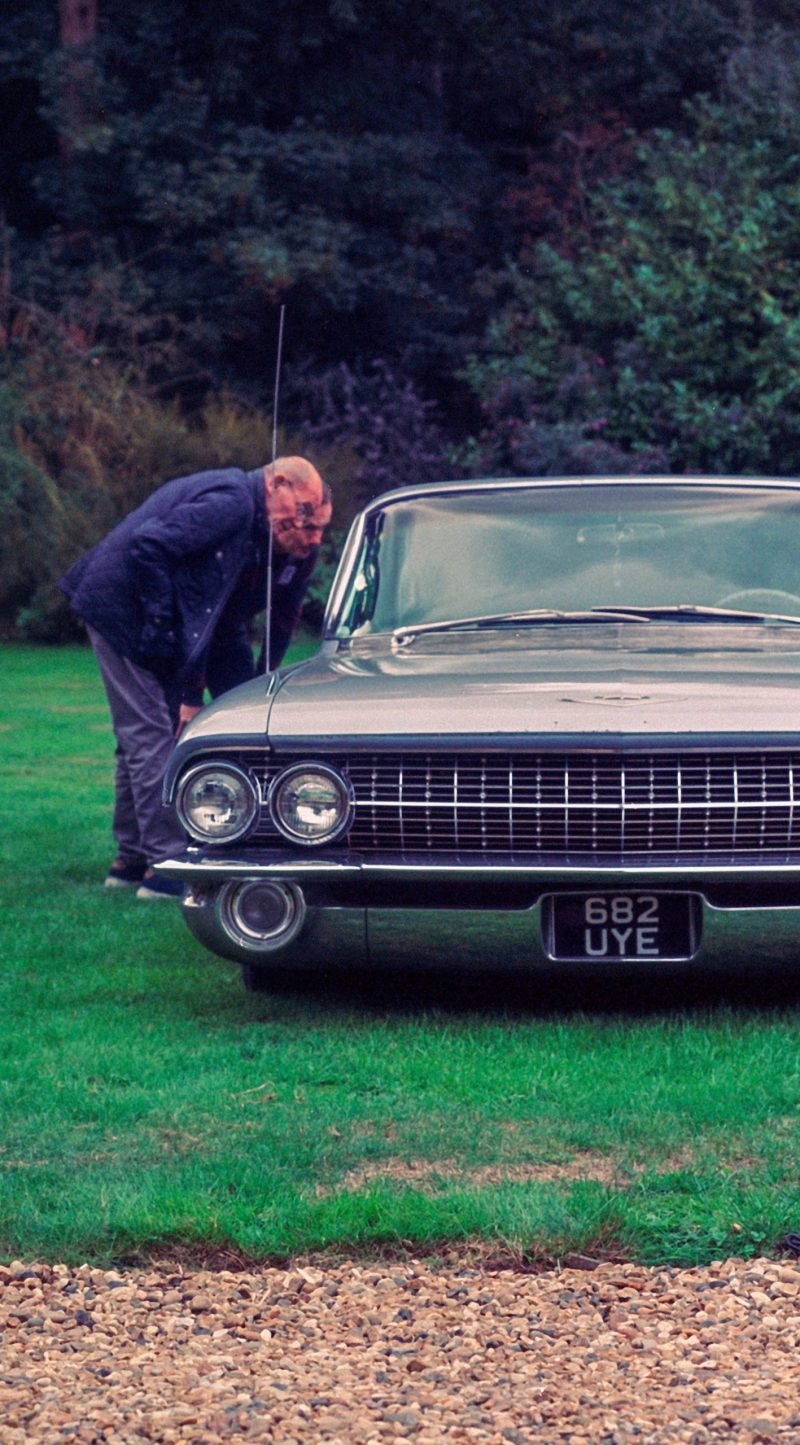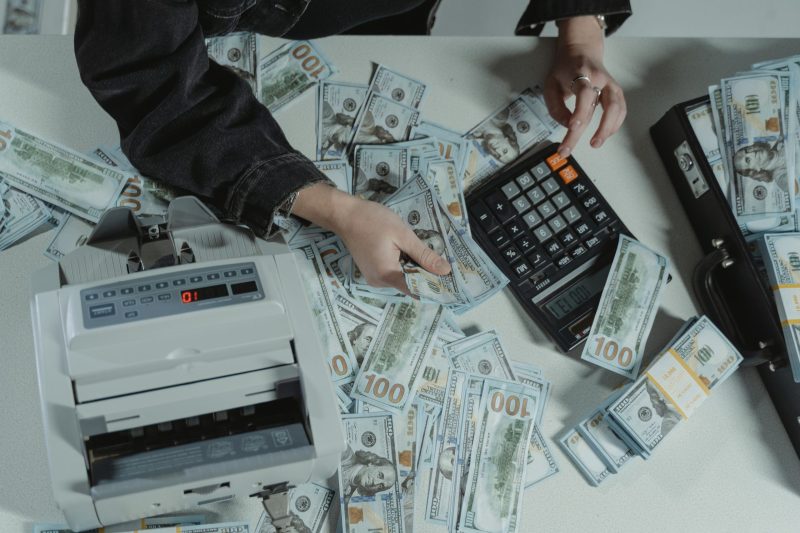☰
- Home
-
Solutions
Transformative solutions we deliver
- Carfax
- GoCRM
- Integrations
- About Us
- Contact Us
- Let's Connect
- Home
- Solutions
- Carfax
- GoCRM
- Integrations
- About Us
- Contact Us

You must start imagining fresh, cutting-edge ways to communicate your brand’s message as individuals (especially younger generations, like millennials), who are more hardened to advertising, become more and more apathetic to it. According to studies, as social media usage increases, people are turning less to advertisements and more to the views and experiences of their peers when making decisions, particularly about purchases. Utilizing your own staff to spread your brand messages is a simple way to profit from this trend.
Instead of being perceived by many people as being untrustworthy or only interested in making a sale, your staff is respected experts among their peers. If your audience doesn’t feel like they are being marketed to but rather informed by a reliable source, they will be more likely to read your message. Because the opinions of your employees are genuine and credible among their peers and acquaintances, developing a message that they wish to spread will greatly expand the pool of prospective customers for your business. When compared to the same messages sent via the official brand social channels, brand messages were shared by employees 561% more widely. When employees spread brand messages instead of the brand itself, they are shared 24 times more frequently.
What To Do First
You’ve probably already recognized how crucial it is to include your employees in your social media strategy after hearing these startling numbers, so allow us to provide you with some advice on how to get started.
Create A Program With Incentives
Create a program that pays employees for providing information about the business; it doesn’t have to be elaborate or difficult. Asking staff members to submit photos of team gatherings (team breakfasts, parties, or trade exhibits) so that your marketing team may share them on the company’s official pages for public exposure could be an easy way to start. Giving out monthly awards to the staff members that participate in the company’s social media initiatives the most is a fantastic alternative.
Give a centralized communication tool
To communicate updates with your staff, use a private Facebook group, an email list, or a group messaging app like Slack or Yammer. These tools are fantastic for ensuring that everyone is on the same page and effectively reflecting the brand. Your employees will feel more invested in the business and more involved if you post updates frequently on these channels. They will also have greater freedom to choose whatever issues they feel are significant enough to discuss with their networks of friends.
Spotlight Personnel
This one is related to a program with incentives. You can inspire others to strive for recognition by openly praising staff members on social media. Additionally, regardless of how big or small your business is, this is a fantastic method to boost morale and foster teamwork. Tag that employee in the post to get visibility to their audience as well, which is another simple approach to boosting engagement.
Get together with your team and decide the best methods. You can start incorporating them into your marketing plan right away now that you are aware of why your employees are so crucial to your strategy and that you are aware of some initial recommendations.
First Step: Make sure your brand and culture are accurately portrayed so that both the company’s official platforms and those of your employees are delivering a consistent message. This is the first step in involving your employees in your company’s social strategy.
Download our free Ultimate Social Media Checklist to help you strengthen your current strategy and increase your social presence if you want to make the most of your social media presence.
Remain SimpSocial!

— AS WELL AS WHY INTEGRATED MARKETING CAN HELP FIX THEM
Risk is not unusual in the financial sector. So why are you sticking to the same disjointed, out-of-date marketing approach from five, ten, or fifteen years ago just to be safe?
The special issues facing the banking sector call for some inventive solutions. Your marketing approach must be in line with your company’s objectives if you want to remain competitive in the face of rising customer expectations, governmental scrutiny, and competition from tech companies.
Here are three urgent issues that your financial organization is facing, and how integrating your marketing strategy can address them:
Are You Prepared for Millennials, Mobile Devices, and Your Marketing Strategy?
I hardly ever visit banks. Instead, I utilize banking applications, like the majority of millennials, to do things like check my account balance, put $5 into savings, and send money to my roommates when we share pizza on Friday nights.
Some may think of me as simply another twenty-something managing the complexities of personal finance. To be competitive, financial marketers must be aware of a bigger trend that is illustrated by my online and mobile banking behaviors.
Integrate Yourself Across All Platforms.
The Fed reports that 67% of millennials use mobile banking, and more people than ever are utilizing personal finance applications and websites. A marketing approach that is exclusively optimized for desktops won’t cut it anymore because your clients are actively using their smartphones for everything from budgeting to investing.
However, outside of banking, mobile usage is increasing, accounting for 52.7% of all internet traffic in 2016. Given that we are in the era of smartphone, financial marketers must be careful about how their material is shown on mobile devices.
Integrating not only guarantees consistency in branding and voice but also produces fantastic user experiences across iOS, Android, and other platforms. This contributes to providing value to your clients and keeps your financial organization one step ahead of the competition.
Tap Millennials into Your Strategy Integration.
Only 27% of millennials, according to a study published by the George Washington University School of Business, seek expert financial advice on investing and saving. Furthermore, even though 31% of all millennials have multiple sources of long-term debt that are still unpaid, only 12% of them reportedly sought professional debt management help.
The financial industry has historically mistreated millennials, despite the fact that they endure more severe economic hardships than Baby Boomers and Gen Xers (shout out to college debt!). This means that there is a huge opportunity for financial institutions to serve millennials, and you may reach this demographic by integrating your marketing campaign across platforms and devices.
When I remark that millennials are a generation that is “literally glued to our smartphones,” I believe I can speak for all of them. Whether we’re using our phones, tablets, or PCs, becoming connected with customer-focused messaging that resonates across platforms will help attract and retain customers in our demographic.
Consistent Marketing Messages Creation
Because modern consumers are always connected to technology, they demand more than just a smooth brand experience. They count on it.
In light of this, your business should think about a range of marketing strategies, including social media advertising, inbound content marketing, and search engine optimization.
By integrating your marketing strategy, you can make sure that your institution’s goals are reflected in your messaging and branding across all platforms and channels. In the intensely competitive environment of the financial sector, you may reach more individuals with a single, consistent message.
By working with a fully integrated ad agency like SimpSocial, you can be sure that your prospects are receiving a single, concise message. Additionally, you don’t have to worry about managing several vendors, which can result in fragmentation, because everything from PPC to creative is handled in-house. Working with a single integrated agency also guarantees that everyone is focused on your company’s objectives rather than vying for the largest share of your marketing budget.
Kick-Start Step for SimpSocial: What sets your financial institution apart from the competition? What do customers appreciate about your business? When establishing an integrated marketing strategy, ask yourself these queries. Create compelling messaging that connects with your audience using the answers you come up with.
Making Interesting Financial Content
Your job as a financial marketer is to create a fresh message that connects across all marketing channels in a world where banks consistently produce the same boring information.
You cannot copy what others are doing and expect to stand out. Instead, you need a comprehensive plan that combines interesting, instructive content to humanize your business.
Use Integrated Marketing to Create Memorable Stories.
Forget for a moment about numbers and statistics. The perception that finance is dull and difficult to understand can be dispelled by using an integrated narrative strategy.
People adore tales. A compelling narrative helps humanize your business across all of your channels, including your blog, social media, and newsletter, especially if your industry has a reputation for being dry. However, you must first establish messaging consistency for each channel. Following that, use content to inform rather than pitch your audience.
Be NerdWallet-like.
NerdWallet, a personal finance website, excels at educating its audience, particularly on its blog, which employs informative, interesting content to instruct readers about everything from credit cards to student loans.
NerdWallet’s brand is consistent across all channels, including Instagram and Twitter, in addition to having excellent content. This expands the audience for NerdWallet and demonstrates that financial content doesn’t have to be dry. You can establish yourself as a thought leader in the finance sector and create a brand that clients can trust by using a similar comprehensive strategy.
Make It Rain Now by Integrating Right Away!
Partnering with an integrated agency is an investment your financial institution can rely on in a sector where taking risks is the norm.
SimpSocial is a fully integrated company that combines cutting-edge tactics and technological innovations to support organizations in the financial sector in overcoming obstacles. As your strategic partner, SimpSocial will make sure your marketing initiatives are in line with your company’s goals in order to help you reach your target market and draw in new clients.
Would you like to integrate with SimpSocial? Let’s have a conversation.

Nowadays, purchasing a car involves a little more than simply walking into a dealership, perusing the stock, and leaving satisfied.
In this increasingly digital era, it’s critical to understand how to interact with potential automobile customers. For some advice on how to stand out and inform potential clients, keep reading.
It’s Important to Have Access to Information
These days, there is a ton of information available online. Even though your dealership may already have a website, take a moment to consider its usability and design. Is it simple to read the information? Is it educational? Do the drop-downs have a clear purpose, and are they organized well?
Let’s look at some useful features a dealer’s website ought to have to attract potential customers.
Vehicle evaluations: Whether a customer is new to the dealership or has previously owned several vehicles from the brand you represent, it’s likely that the lineup has changed and new features have been added. A car review summarizes a car’s specifications, interior features, and other details.
Comparisons: Nowadays, a lot of drivers conduct research, but they want to be aware of their options before going to a dealership. Comparing vehicles, either between brands or within the same brand, is one way to do this. By giving drivers vehicle comparisons, they can evaluate an automobile on their own.
Resources that are easily accessible: According to AutoTrader, 72% of drivers prefer to fill out the credit application and associated finance documentation online. This tool should be accessible online, along with others like a trade-in value calculator and a payment calculator.
Social Media Usage
It makes sense to sign up for and be active on TikTok and Facebook, given their continued rise in popularity. But what should you do when you’re actually behind the wheel?
Utilize these options to let clients know about forthcoming activities you may be hosting, such as barbecues in the summer or coat drives in the winter. Customers should be informed on social media when a new model is introduced or the pre-owned inventory has just been expanded. It’s a simple method to connect with people and advertise your company.
Effectively Engage Your Customers
Being able to communicate and interact with potential car customers is crucial. SimpSocial can develop an integrated marketing plan that meets your needs. We anticipate hearing from you. Call us right away!

Advice on Keeping Your Blog Interesting and Fresh
It’s not as difficult as you might believe to gain new readers to subscribe to your blog and draw in consumers. You might be boring your audience, though, if you’ve observed decreased engagement, fewer followers, or a general lack of interest in your postings. Readers of today are readily persuaded by what you write and how you write, and they won’t think twice before clicking that dreaded button.
Recognize Your Audience
Identifying your target audience is the first step in creating a great blog post. No matter what industry you work in, there are people who are not just curious to learn more but are also actively looking for the services you provide to address an issue they are currently experiencing. You want to “wow” them, but refrain from bragging. Simply engage them with entertaining and educational content, and act as the approachable solution they seek.
Create Regular Posts
It not only helps you grow your audience, but it positions you as a voice that people are truly interested in when they have a fresh post to read every few days. People will start to lose interest and move on if you don’t publish a fresh blog post. Establish a posting schedule to keep up with demand.
Interested Readers
One of the reasons you blog is to increase engagement, so take advantage of the opportunity to engage with your readers by addressing any queries and leaving comments. If a reader is aware that you’re there to offer information not covered in the piece, they are more likely to stick around and suggest your site to others.
Change the way you phrase your sentences.
Many writers prefer concise sentences. They are simple to compose. In that manner, Hemingway wrote. However, using too many brief sentences will harm your blog. You should switch things up. Is this passage not boring?
Short sentences might actually annoy your readers because they give them too many opportunities to pause, glance at other open tabs, or get up from their computers. Your readers will be more engaged in your writing if you blend longer, more complicated phrases with brief ones.
Keep your sentences brief.
Unbelievably, most material is read on smartphones. Smaller paragraphs on your blog are a result of smaller screens. Like a door handle during flu season, long paragraphs are typically avoided, especially when they are displayed on a small screen. A reader may swiftly leave a long wall of text in order to save their thumbs from the strain of having to scroll past the next subhead.
Create Content That Stands Out
It’s always excellent to be a new and distinct island in the unending digital sea, regardless of whether you’re in a crowded industry or one of a few in a unique firm. To really communicate your points and keep your blog engaging and functional, write a story, publish lists, or upload entertaining infographics. Readers will return if your content continues to be intriguing, unique, entertaining, and engaging, and your audience will expand.
It’s time to put the tools to use now that you have them. Publish a brief, entertaining, interesting, and original blog post to observe how your readers react. Answer their queries and remarks, and provide them with further details and explanations. To find out more advice on attracting readers to your site, get in touch with us.

What does the website for your company primarily serve?
You want to increase the number of visitors who become paying clients so that you can make money, right?
Collecting their website clicks is one of the most crucial phases in bringing these potential consumers into your sales funnel. Visitors are more likely to convert if they click more often. Therefore, one of the main objectives of digital marketing is to optimize every little detail of your website in order to promote more clicking and, consequently, increase the number of conversions into actual paying consumers.
Describe CRO.
We refer to this as CRO, or conversion rate optimization. Your conversion rate will increase the more parts of your website you test, keeping the ones that work the best. Testing headlines, colors, calls to action, and other choices are recommended.
Do you want to know how a CRO test may make your site better? Chat with me!
Let’s examine a case in point. In this traditional A/B test, we examine many iterations of the same site piece to see which generates the most conversions.
On a vehicle dealer’s inventory page, this is the primary call-to-action button that we are examining. “Conversion” is defined as clicking this button to send a form asking for more details about the car.
The initial button is blue and says, “Click for a Custom Quote.” The second button next to it says, “Appraise your trade-in.”
To determine which version generates the most conversions, we will test the original against two alternatives.
Since there are fewer options to click on, we start by changing the button with the copy “Send Me Today’s Best Price” and deleting the “appraise your trade-in” button, which we know from agency experience performs well on car dealer websites. This will be the initial iteration.
The second version is the same as the first, except the button is colored green instead of the other colors found on the website, making it stand out more.
To test all of the buttons at once, each of these variations will be distributed to randomly chosen website users. Testing at a different time or day prevents the data from being distorted.
We can select the top button and permanently add it to the website after one of the variations significantly boosts conversions to the degree of statistical certainty we want.
The CRO Test’s Findings
We have gathered enough information after a few weeks to choose a winner. The variations’ conversion rates are as follows:
Initial: 88%
Send Me the Best Price for Today: Blue: 89%
Send Me the Best Price for Today: Green: 91%
We can be confident that the green button is the best option because it has the highest conversion rate and a statistical confidence level of 99%. We will therefore permanently add this button to the website.
allowing users to improve your website
The best thing about CRO testing is that it removes the need for you to rely just on intuition; instead, your website visitors will tell you which version of the site they prefer, providing you the opportunity to immediately address their needs and convert them into paying customers.
Although you might like the blue button, more paying clients will choose the green button, which will ultimately boost your revenue. Just consider the amount of money you would eventually lose if you just used the original button variation.


Describe PR. The goals of a public relations professional should be to manage the firm’s reputation by communicating with the public on its behalf and handling internal corporate events that occur. These indispensable people have existed for as long as a business has existed. There are numerous new changes in the field of public relations as the digital age enters its formative but encroaching adult years, but are there also any parallels? This comparison of traditional PR vs. digital PR covers everything.
The Principles of PR
Press releases and business events were both parts of old-school, or “traditional,” public relations, and each was a crucial component of the strategy. In the past, a PR expert would frequently contact the local TV stations, newspaper editors, and radio personalities using a Rolodex that they kept on their desks. At least once a month, they would communicate with these sources. Additionally, it was their responsibility to tell the public about the company’s location and other pertinent facts. For each event involving the company, a press release would be created and distributed to the media using this kind of material.
The last section of reputation management, crisis management, or public relations is likely the most remembered. This covers remarks made both favorably and unfavorably about the business, a worker, or the sector as a whole. Consider this: I’m sure a few businesses had something to say about cigarettes being dangerous for you back when someone boasted about it.
The Role of PR in the digital age
Modern society relies heavily on digital technology. visiting with friends? On your phone, text them money to pay the check. Want a ride? You can quickly call a car online. Discover the shoes you must have. You can order them from your phone, check them out online, and choose from five different color options.
For PR professionals, “digital” refers to an organization’s online presence, particularly in terms of controlling that presence to ensure that the public isn’t using outdated or inaccurate information.
A recent development in the PR industry, search engine optimization (SEO), has quickly established itself as a starter. The major goals of SEO include improving search engine rankings (such as those on Google), establishing a varied backlink profile, and raising brand awareness in local communities. This has given agencies a significant new arrow in their quiver of digital marketing tools.
The majority of the PR component of SEO involves managing a company’s or client’s brand and making sure that the web content establishes a consistent and accurate presence. False or inaccurate information is detrimental to any company, so digital PR specialists need to be aware of it.
Is there a distinction?
You can see how similar the concepts of traditional PR and internet PR are. The practice of creating and managing a company’s public presence through news releases and outreach has been made possible thanks to the public relations of the past. The basics that have been developed over the years in public relations may teach digital PR a lot.
Consider a time 40 years ago when a business hosted or sponsored a function. To spread the word, a newspaper ad or possibly a press release would be placed. Today, the same event would simply have a different medium, like a Facebook post or an online magazine advertisement.
Public relations has always been essential to running a business, and in the rapidly evolving digital age, it will require more improvisation than ever.

You believe your product is excellent. It is the best of the best. However, there is always a potential opponent on the other end, namely the client.
Regardless of whether a customer makes a purchase in person or online, it is always important to keep in mind what they are looking for. But how do you succeed and make sure your firm is successful? Knowing what customers want before they buy is useful.
Reputation is always important.
Potential clients are continually thinking about your company’s reputation. These could be returning clients or brand-new ones who have never done business with you before. Customers will look up reviews of your company online, where they can naturally find a large number of them. This implies that the daily interactions you have with consumers in person could eventually result in stories being recounted online.
Remember that a negative review doesn’t have to be awful if it’s constructive and honest; customers will discover that it provides context. Make sure all of your interactions with customers and communications with them are kind, straightforward, and customized.
What Sources of Information Are Used?
Before making a purchase, consumers will conduct their own research. This includes using your firm’s website, speaking with a salesperson or other in-person company representative, or even having a face-to-face discussion with a friend, family member, or another individual who has previously held the position they are applying for.
A widely used method of gathering information prior to purchasing is asking someone for advice. But it’s also important to make sure your internet presence is current and useful. Your website needs to be updated frequently with new content that highlights the newest goods and services. By creating content, you may increase the number of people who find you and grow your business. Of course, face-to-face communication is still crucial.
Link Up With Your Clients
Before making a significant purchase, consumers need to feel knowledgeable. You can get assistance from SimpSocial to build a marketing presence online that works for you. To find out more about how we can improve your customer interactions, get in touch with us right away.

The next time you need a caffeine boost, you don’t have to be content with generic coffee from a big-chain store. There are many locally owned small businesses in Philadelphia, including coffee shops.
When we go down in the afternoon, our Philadelphia office has chosen a few of our favorite locations to go to. Look it up!
Facebook: GreenStreet Coffee
GreenStreet Coffee is a locally owned and operated coffee shop that is dedicated to sustainability and ethical business methods. It is situated on the corner of 11th and Spruce Streets in Midtown.
The shop’s original owners, Chris and Tom, are still employed today. They aim to retain a presence in the neighborhood and create a friendly, relaxed atmosphere.
Customers are welcome to create their own brewing recipes, and every ingredient is carefully obtained and sustainably chosen.
Coffee Elixr | Facebook
The Philadelphia region is home to three different Elixr sites, all of which originally opened their doors in 2010. With its distinctive roasting and sourcing methods employing hand-selected ingredients from throughout the globe, this business stands out from the competition. The mildly roasted flavor of an Elixir cup of coffee is its distinguishing characteristic.
You may see the newest works of local artists on display at every Elixr outlet if you enter. Elixr, which also functions as an art gallery, is dedicated to supporting emerging artists in the Philadelphia region.
Coffee LaColombe | Facebook
LaColombe keeps expanding its presence across the nation and building a solid reputation for itself. LaColombe is a mainstay in the Philadelphia neighborhood and is renowned for its inventive recipes and ethically sourced ingredients. The flagship store, which is in the center of Fishtown, is a sight to behold. Owners JP and Todd have taken over the structure, an old warehouse. The two transformed the area into a full-service coffee shop and mini distillery. Try the draft latte, which is its claim to fame.
Purchase a coffee in Philadelphia.
Try out our suggestions the next time you’re in Philadelphia if you want to try a new coffee shop, and let us know what you think!

You must choose a goal for your blog before you start writing. If the goal is to inform readers, you must determine whether they will find the information valuable or informative.
Additionally, you should ensure that your work will be time-effective for the reader. Make every word count because, for people, time is everything.
Understand Your Market
You need to decide who your blog is now that you know why you’re writing it.
According to an old proverb, “If you try to please everyone, you’ll end up pleasing no one.” As a result, you must identify your ideal client, which you may achieve by developing a buyer persona.
Your tone and message will be more precise and concentrated once you’ve done that.
Make it your own.
It’s fantastic to produce instructional materials. However, your readers ultimately want to get a feel of who you are. In doing so, you can show that you’re both relatable and a thought leader in your industry.
To keep your readers interested, keep your tone informal. Avoid seeming robotic by taking the following actions:
To address the reader, use “you.”
Pose queries to elicit thoughts from the reader.
To make your postings more vibrant, use metaphors.
By using these suggestions, you’ll sound more genuine and can start building trust with your audience.
Create Relationships
Regularly producing interesting and educational content can help you establish a connection with your readers. They will continue to seek you out if they have confidence in your knowledge. In the future, they’ll be more likely to employ your services as well.
Connect with your audience now.
As you can see, a good blog can educate readers while still keeping their attention. Contact SimpSocial Companies right now to get started if you’re prepared to share your material with the online community.

Participating in social listening is crucial for maintaining and managing your reputation. I’m not referring to reviews on Dealer.com, Google My Business, or even Facebook. I’m referring to the discussions your customers engage in when they believe no one is listening. You can learn the most about how your customers view your brand when you aren’t labeled specifically or when there is a discussion about your brand that isn’t meant to be engaged with.
What are your social listening strategies?
No matter the size of your business or the goods or services you provide, social listening is something you ought to do. This can range from cost-effective software that enables you to search for material using your brand name, services, goods, or even hashtags that are pertinent to your business to free techniques like setting up a Google Alert to track your online presence.
How you may take advantage of this:
A micro-influencer who has really expressed their appreciation for your products and is a fan may exist. This may be confusing in all of your mentions, which would result in you missing a fantastic cooperation opportunity.
Social listening can be used in a variety of ways to snoop on your rivals. This might assist you in identifying any characteristics or services that your rivals’ clients might find lacking or desirable. This can also keep you informed about prospective buyer personas that you might not have yet completely exploited.
Adding to point two, imagine that you work for a national towing company and that your social listening includes phrases like “flat tire” and “dead battery.” Then you can locate those who require your service immediately and provide them with a discount or perhaps a free service. Something along the lines of “Flat tires are rough.” Likewise, renting a tow truck Give us a free ride so we can at least make this horrible scenario a little better! Call us and reference this tweet when you do so.
How do you determine whether to participate or simply listen?
When someone has a flat tire or a dead battery, as those are smaller, less critical issues, you might wish to intervene. A promotion may seem tacky if there was a significant accident or anything more serious, though.
Only you and your company can decide where the line must be drawn. For some people, responding to every post could be a good idea, but for others, it might come across as spammy and desperate. Equally crucial is knowing when to join a social conversation involving your rival. Will trying to enter with a sarcastic remark like Wendy’s on social media be kitschy? Or will it appear insincere and fail, provoking a negative response?
Are you prepared to start a discussion about social management and listening online? Chat with me!

Google, Bing, and other search engine algorithms are kept a well-guarded secret, which is the beauty of search engine optimization. Testing various theories on their own websites or reading stolen information from Google staff are some methods by which marketers might determine what is successful or unsuccessful. It’s crucial to share certain notions that have been debunked as “SEO myths” by algorithm upgrades and penalties so that your company doesn’t suffer on the SERPs.
Myth: My page will rank #1 if I use all of my keywords on it.
One of the SEO myths we hear the most is this one. According to this notion, you can obtain the top organic rank if you list every single one of your keywords on your site. This may have been effective during the early days of the search. Semantic search, however, has been perfected by Google and other search engines. Semantic search is the practice of determining the relevance of a search query’s context in order to produce a more thorough and detailed collection of webpage listings. Because of this, keyword stuffing is recognized by search engine crawlers, which is evident in your poor rankings.
Myth: I will rank well as long as my content is good.
“Content is king!” is a phrase we frequently hear. Yes, your content should be educational, easy to read, and provide the information your visitors need. Your content’s format is becoming more and more important, though. Since featured snippets and quick answers have been introduced, there is a specific way to format your information such that it will fit neatly into a snippet. The easiest way to decide how your blog or landing page should be designed is to look at what is currently ranked for that position and use the Google-approved layout.
Myth: If I blog regularly, my SEO will be good.
Adding pages to your website will undoubtedly increase its natural visibility. You can have a passable SEO program depending on the caliber of your material, the strategy of your keywords and inbound links, and the frequency of how you post. The ranking method, however, takes a great deal more into account. During algorithm upgrades, factors including site speed, picture alt text, inbound and outbound links, and more are all taken into account. Even if you are producing material frequently, if your website has numerous technical issues and a disorganized layout, you may soon find yourself on page 10 of Google.
Myth: If I have SEO, I don’t need paid search.
We are all aware that paid search (PPC) and SEO are two entirely different types of marketing. If there are four ads at the top of the SERPs, how can you be the first organic ranking for any query relating to your business? On desktop screens, the mere existence of ads sends organic results halfway down the page, and it seems even further on mobile devices. Depending on the level of SEM competition right now, running sponsored search advertising for specific keywords may occasionally be necessary. Additionally, your company can occasionally be holding a promotion or sale where you require instant online exposure. You should launch a PPC campaign for these kinds of keywords. Consider PPC as a sprint, and SEO as a marathon. You could wish to run another marketing channel in addition to your SEO if you need visibility right now.
Myth: The happier you are, the more backlinks there are.
Having as many backlinks as you could at the time of black-hat SEO methods was a way to boost your SEO. Google and other search engines have surpassed that in modern times. Make sure you’re concentrating on quality rather than quantity of backlinks. Focus on creating genuine collaborations and guest blogging for other websites instead of building spammy or purchased links, which are discouraged in organic search.
Myth vs. Reality
Although there are numerous SEO misconceptions, the ones mentioned above are some of the most prevalent right now. What can we learn from disproving these theories? There are numerous factors considered during the ranking process. Find out what those factors are and strategically use them.
SimpSocial is a full-service company that can help you grow your business. We provide numerous packages across the U.S.

In a single day, the average person views 4,000 to 10,000 ads. What does that entail for you and your company, then? You want to make sure that your advertisement stands out from the sea of advertisements that your audience sees every day due to its sheer volume.
Fortunately, doing that only requires applying a few techniques that will turn the generic copy of your company into something special.
You only need to take a moment to read this primer on the secrets of effective content, which was written by the marketing experts at SimpSocial. With the help of these practical tips, you’ll learn more about what makes a piece of content motivate buyers.
Tip #1: Express some emotion.
Emotions are the primary determinant of decision-making in the human brain. In fact, research has proven that your buyer is more likely to purchase your goods the more emotionally impactful your content is on them.
Additionally, emotional advertising outperforms its less emotional rivals in terms of revenue, profit, and market share gains.
What does this imply for you personally? Simply put, adding a little emotion to your text will undoubtedly motivate your audience to take the desired action.
In order to motivate your ideal customer to buy what you’re attempting to offer, your ultimate goal is to appeal to their emotions.
Desire has been shown to be one of the most powerful emotions to appeal to when trying to persuade customers to choose your company.
One effective strategy to pique the interest of your audience is to sell an SUV in a way that illustrates how it may help parents stay on schedule and more organized.
Writing for Your Audience is Tip #2.
It’s crucial to make sure that every piece of content you produce is targeted toward the appropriate audience, continuing our SUV example from our first suggestion.
By focusing on the reader’s needs and the advantages of your product, you’re more likely to establish a personal connection with them.
You should alter the topics and context of your copy based on the customers who are most likely to buy the product, as opposed to creating all of your content for the same buyer.
This will not only make it easier for your audience to relate to the text on the page, but it will also give them the impression that your company is acutely aware of their problems. As a result, your customers will be more inclined to make a purchase, which eventually results in higher sales for your business.
Practice the Art of Readability, the third tip
Above all, writing in a way that is both clear and simply consumable is the best approach to connecting with your audience and inspiring them to take action.
One of the best ways to do this is to create content that succinctly explains the advantages of your product and how those advantages will improve your customers’ lives.
Furthermore, scannable information makes it easier for desktop and mobile readers to quickly understand the main points of your copy. You can use the following techniques to make your copy easier to read:
A list of bullets
Charts
concise paragraphs
Subheads
lists with numbers
Additionally, maintaining white space on the page gives the reader’s eye a place to rest and prevents the client from becoming overwhelmed by the volume of content. All in all, these suggestions assist you in producing marketing content that is more approachable to a range of people.
Discover More About the Success Factors for Content!
Now that you are completely aware of the secrets to effective content, it’s time to select a group of marketing experts who are knowledgeable about writing copy that will arouse desire and convert leads into purchases.
All you need to do is get in touch with SimpSocial, your fully integrated advertising agency, and ask to speak with their team of creative content marketing professionals.
With our assistance, you’ll begin to enjoy the advantages of content created to entertain and meet the needs of your audience. Contact our staff now to get going!

Nowadays, the internet is a part of almost everything we do, and promoting your business is no exception. It certainly makes the most sense to make the most of the internet in order to reach the largest audience and, more crucially, your target customers. But how is it possible when the internet is evolving so quickly in front of our very eyes? This manual will teach you everything you need to know about the most recent developments on the internet and how to make the most of them to grow your business. Let’s begin by taking a quick look at the most current developments on the internet!
The Shortest Possible History of Internet Evolution
There is no denying that the internet is evolving. Hundreds of thousands of new online pages and ways to interact with them are added every day. About 15 years ago, internet users had to physically type their inquiries into search engines like Google and Bing while seated at a computer.
Later in this time period, prospective consumers and customers might conduct these searches from locations other than their home computer lair by using mobile laptops. The online procedure stayed the same, though.
While more than 95% of Americans have traditional cell phones, more than 80% now own and use smartphones. Around 37% of smartphone owners, according to Pew Research Center research from June 2019, “now go online mostly using a smartphone.”
Going where your consumers are is an age-old business strategy that is now being applied to mobile marketing. The final truth is that you must embrace mobile marketing if you want your company to remain competitive.
How to Win Tomorrow’s Internet Marketing Competition
Mobile marketing is currently the single most crucial factor to take into account when using Internet marketing. The likelihood that the customer you’re attempting to reach will view your website via a smartphone rather than a desktop computer has already been discussed.
You should optimize your website so that it appears just as excellent on a mobile device as it does on a computer in order to connect with as many potential clients and consumers as you can. Utilize these useful strategies to maximize your mobile marketing strategy:
Make your website responsive to mobile devices.
Your responsive website should look just as good on a tiny vertical screen as it does on a huge horizontal one. This includes formatting it so that elements like drop-down menus work properly, the font sizes are accurate, and everything is appropriately layered.
2. Adhere to best practices for SEO.
Search engines will function in the same manner on a desktop or laptop as they would on a smartphone, even if many of your potential customers and clients may view your company’s website from one. You should therefore continue to use local SEO best practices. To enhance traffic and your rankings, keep using “near me” content and other local keywords.
3. Make use of text message advertising.
While text messages are still significant and can be helpful to your plan, cell phones are made to make it easier for you to access the internet via a web browser. Smartphone users will be able to visit your mobile site right away by clicking a link in a text message.
4. Take into account all search types.
Right now, entering a query into a search engine’s search box is the most popular method of conducting a search. However, the majority of smartphones come with technological tools that can hear and understand voice commands and speech searches. By including fully formed, long-tail keyword-packed inquiries like, “Where can I get an oil change near me?” in your content, you may optimize your website for voice search.
A Little Help, Please, Putting a Plan Together
In order to help our clients achieve their full online potential, we at SimpSocial actively follow the development of the Internet. We deliver retail traffic for each and every one of our clients using a range of techniques and tactics. Want some assistance growing your company? Contact us right now!

Due to the growing popularity of websites like Vroom and Carvana as well as the overall inventory shortage, which has forced customers to search longer online for inventory that meets their demands, consumers are spending more time buying online.
As a result, customers are visiting fewer dealerships in person before making a purchase. Additionally, only about a third of customers actually complete their shopping on the dealer’s website, meaning that two-thirds of customers begin and end their customer journey on a third-party website.
This implies that your leads are not just your leads. At least 65% of the time, customers are directly comparing your inventory, pricing, and customer service to those of your rivals.
Customer loyalty and lifetime value are crucial, but the leader needs to be converted into a customer first, and your dealership is in real-time competition with a number of others for the opportunity. Vin-specific leads are more focused and more likely to result in sales, but other than increasing the lead’s quality, the best strategy for capturing buyers who are considering multiple dealerships is to simply arrive first.
With SimpSocial, you can ensure that more customers start and complete their customer journeys in your store thanks to our lightning-quick response times and excellent appointment setup strategies.
Buyers who viewed numerous websites visited third-party websites first (65%) and last (58%), respectively. Additionally, dealer websites are crucial, particularly at the conclusion of the purchasing process, when 32% of auto purchasers complete their internet research.

However, according to Autotrader’s 2023 report, 80% of shoppers are now willing to complete their purchase entirely online, and 70% say that they are more likely to buy from a dealership if they can begin the process at least in part online. Just before the pandemic, 81% of consumers surveyed stated that they intended to complete their purchase in person*.
Due to low inventory and unpleasant user experiences, customer satisfaction scores have decreased at the same time as consumers report spending more time shopping online. As a result, it should come as no surprise that consumer demand for open and trustworthy vendors and services is at an all-time high.
Without the advantages of face-to-face human engagement made possible by in-person visits to the dealership, it can be difficult for dealers to establish trust and retain loyal customer relationships.
The answer is customized business development and customer interaction, both online and over the phone, that is well-coordinated with efficient online procedures to reduce the trouble for the customer.
It is crucial to partner with the proper SimpSocial to enable quick and efficient customer engagement that starts establishing trust with the customer at the very beginning of their journey. This is important for both customer happiness and conversion.
The key to the company’s success is its tried-and-true process for establishing trust with customers over the phone, which has helped it become the fastest-growing and most successful in the sector.
www.simpsocial.com / SimpSocial (888) 829-1110

Numerous factors have contributed to a decline in customer satisfaction over the past two years, but one that customers regularly cite is time. Consumers’ overall satisfaction with the buying process and the value they receive from the dealership are closely correlated with the length of time it takes to complete the transaction.
Consumers are aware that the old procedure is no longer essential, which required them to put up with filling out paperwork and waiting for permissions for a whole day. Consumers consequently anticipate a superior, more contemporary, and practical experience, comparable to what they have grown accustomed to when making other purchases, both significant and trivial.
Both online and dealership time increased in 2022, but dealership time is where consumers are most dissatisfied with the process overall. In fact, the completion of the finance application procedure online can save the customer an average of 2 hours at the dealership, according to Cox’s 2022 Car Buyer Journey Top Trends report*. According to the report, 44% of customers say they will only shop online at stores that help them fulfill their prerequisites for purchases online. With a user-friendly, streamlined online and mobile approach, progressive, technically adept solution providers are coming up with innovative solutions to cater to consumers who are concerned about the value of their time.
Without a significant investment in modernization, dealerships that are unable to take advantage of today’s technological advancements to provide customers with the convenient, user-friendly experience they demand are so far behind their more technologically advanced rivals.
Utilizing the technical know-how and sophistication of SimpSocial has proven to be a very cost-effective way for hundreds of dealerships throughout the nation to streamline their customer experiences and convince customers that any necessary in-person appointments would be worthwhile.
The CEO of Cars.com, Alex Vetter, was quoted as saying last week that less tech-savvy dealers still had a long way to go.
“If you look at younger generations, they use technology at a pace that is four to five times that of the typical owner-operator…… Dealers that adopt a digital-first, completely transparent online [approach] are winning the game. The prices in-store and online are identical. From our website, you can get in touch with us directly, start your adventure, and request any services you need. These are the dealers who are expanding the market and advancing the industry.

The Gift of Gab is more about listening than talking.
The so-called “gift of gab” is actually only deserving of the hype if it is accompanied by a sincere effort to listen to the party being gabbed to, which may seem contradictory. The “gift” of gab refers to the capacity to convince; verbosity is something entirely different.
Asking good questions that encourage the other person to give relevant details about themselves and their viewpoint on the topic at hand is a key component of successful listening.
In a dialogue where one side is trying to sell something to the other, this dynamic is particularly important because preferences and objections need to be identified in order to be addressed and overcome.
The fundamental power of online tools lies in their capacity to persuade and compensate the user to provide information about themselves and their preferences for the goods they are purchasing. The digital experience essentially creates a profile of the customer and offers them customized options for their buying needs in exchange for the information they provide. This procedure essentially replicates what having the gift of gab may achieve through conversation, although it does not usually take its place. The majority of customers concur that a personal touch and a human aspect should be present in the transaction to help them develop trust and confidence in the vendor and the procedure. A well-informed and well-profiled shopper can become a trustworthy and contented client with the use of one’s gift for gab.
The goal of SimpSocial is to maximize the value of every lead, and the company has perfected the art of persuasion and the capacity to coach those with a natural gift for gab to achieve that goal.
Learn more about how SimpSocial can use its propensity for gab to benefit your dealership.

On May 15, KAR Global will rebrand as OPENLANE and go retro.
Retro in that KAR CEO Peter Kelly formerly operated under the moniker “Openlane,” which he co-founded with Andrew Iorgulescue and eventually sold to KAR’s Adesa division in 2011.
Onlane, a Canadian online auction business created by Clive Kinross and Michael Stein, and Openlane (formerly Auto Trade Center – “ATC-Open”) have amalgamated. The ensuing business, Openlane, evolved to become an industry disruptor and attract Adesa’s interest. As they say, the rest is history.
Until May 15th, that is, when a new, lighter version of KAR drops its previous moniker and revives the Openlane brand to commemorate its sale of the burdensome Adesa infrastructure (much to Carvana’s dismay) and to champion its investment in and ongoing focus on the agile model that was formerly and once more known as Openlane.
“We’ve built and acquired some of the leading digital platforms in our industry over the past ten years,” said Peter Kelly, CEO. “By combining the best features and functionality from this technology and unifying our supporting operations, we will help us create the fastest, easiest, and most active digital marketplace available.”
According to a press release, the rebranded business will continue to trade on the New York Stock Exchange under the ticker code “KAR”.
One of the most famous David vs. Goliath tales in our sector is the one involving Openlane. A disruptive force that was simultaneously envisioned by Peter and Andrew at ATC-Open and Clive and Michael at Onlane, and that eventually merged to form Openlane, has grown to seize control of KAR and steer the iconic company in a more forward-thinking and sustainable direction.
SimpSocial congratulates Openlane on its accomplishments and welcomes the brand back to the top of the Auto Remarketing Pack with similar goals for beneficial industry disruption.
www.simpsocial.com / SimpSocial (888) 829-1110

The auto industry has changed, as have the expectations of potential customers, thanks to the transformative acceleration of delivery for just about anything you can buy these days, big or small. However, because of state laws that limit dealers’ ability to perform transactions and door-to-door delivery without a consumer’s in-person visit to the dealership, the process hasn’t been as simple to take advantage of in Illinois and other less progressive states.
A new measure that would allow for 100% online purchases with door-to-door delivery is being worked on to change these restrictions for the state of Illinois.
State Senator Patrick Joyce, a Democrat whose district comprises the majority of Kankakee County and a small portion of south Chicago, shared the following.
In a statement to Automotive News, Joyce stated, “It shows we are on pace to bring the vehicle sales industry into the digital age.” This would not only satisfy the needs of contemporary consumers, but it would also make the process of buying an automobile simpler. The ability to contact clients more easily and close purchases while offering a convenient and secure experience will benefit dealers.
By assisting dealers in making the most of their management of customer expectations in the rapidly developing digital economy, SimpSocial has achieved unparalleled success in the market. We look forward to assisting Illinois dealerships in offering their consumers the benefits of 100% online transactions, complete with door-to-door delivery in the manner of Chicago.
www.simpsocial.com / SimpSocial (888) 829-1110

The top dealership groups in the nation continue to dominate with large inventories, wide-ranging reach, and economies of scale. However, the biggest competitive advantage larger dealership groups have in today’s digital market comes from their continually improving operational sophistication and expert use of technical efficiencies.
“Get big or get out,” “Bricks and clicks is not a strategy that works only for large dealers,” and “Get big or get out” can best describe the future of the automobile retailing industry. The good news is that this bricks-and-clicks approach is not exclusive. It is unpatentable. Any retailer inside or outside of this room is free to adopt it. The secret is to expand. (Alan Haig, president of Haig Partners, LLC, at the April 4th New York Automotive Forum panel discussion on The Future Landscape of Automotive Retailing)
Haig makes the argument that sophistication has less to do with size and more to do with thinking. You don’t need a large dealership or crew to successfully and efficiently use cutting-edge technologies. In actuality, you may be more fluid, responsive, and effective with fewer resources the more sophisticated your processes are.
Regardless of the size of your dealership, outsourcing SimpSocial to market-leading SimpSocial is a very effective, affordable, and non-disruptive approach to benefiting from the most recent advancements in SimpSocial.
In order to overcome potential customers’ objections and gain their consent for a sales meeting, your dealership needs to respond quickly and use a clever message that is disciplined and intelligent.
Customers are encouraged to take the next step in their journey toward making a purchase with your dealership by SimpSocial’s proven processes and unbeatable response times, regardless of size, before they are lured away by your competition, from clients with a single rooftop to the nation’s largest dealership group.
For its dealer clients, SimpSocial significantly improves lead conversion rates and average response times, enabling them to seize digital shoppers and turn them into clients before the competition can. For a customized explanation of how SimpSocial can enable your dealership to use speed and sophistication to compete, regardless of size, scan the code below.
www.simpsocial.com / SimpSocial (888) 829-1110

180 titans of the auto industry are now stepping forward as A Billion. Who will come after?
Unsophisticated dealers are unable to adapt and implement the cutting-edge efficiencies that are setting the pace in the industry due to the speed at which the auto business is currently moving. Instead, they are working with less efficient tools and techniques that once worked.
The opportunity to grow and profit, however, has never been greater for the sophisticated dealer. More and more industry success stories are “going Yard” these days, or surpassing the billion-dollar mark in net worth, which begs the question of who will join Penske, Musk, and Miller on the list of auto industry billionaires.
At SimpSocial, we take pride in helping our dealer clients realize their maximum potential, whether that means “going yard” soon or progressively preparing over the course of a ten-year plan. To learn how SimpSocial’s market-leading solutions may help your dealership hit the ground running, book a demonstration on our website.
www.simpsocial.com / SimpSocial (888) 829-1110

Don’t let your opportunity pass you by; use SimpSocial’s well-proven services to help you make the most of each moment for your dealership.
If you are not skilled at seizing the moment with potential clients in today’s fiercely competitive market, you are probably losing out to rivals who are. Mementology’s rising popularity is directly connected to how well it engages clients at pivotal points in their journey.
The study of moments and creating opportunities is known as “momentology.”
Moments count. Learn them, then create them. – Mitch Abblett, M.D.
Momentology is also known as the study of customers and the digital media they interact with and use during the buying process.**
Are you ready to engage your leads in a way that maximizes ROI and captures the moment?
SimpSocial gives dealerships the ability to
I’ll respond shortly.
Create trust immediately.
incite a sense of urgency.
Quickly convert leads into appointments.
immediate ROI maximization.
all the while permitting your sales team to save their time and energy in securing the deal.
It’s time to take advantage of the SimpSocial opportunity and make the most of every lead. Grab the opportunity. Visit www.simpsocial.com / SimpSocial (888) 829-1110

Never before have dealerships across the nation struggled so much to keep inventory levels the same.
I’ve talked to 75 different dealerships in the last year alone; therefore, I can assume that your dealership is also likely experiencing a severe lack of inventory.
Wouldn’t it be fantastic to purchase an extra 5–20 automobiles each month while paying an average of 54% less than what you would pay at an auction and earning more money overall?
AND have the neighborhood transport these chances to your doorstep so you can have the exclusive chance to purchase them before your rivals can.
The Stock Your Lot campaign has been operating at Ross Dionisi’s Hiley Subaru and Hiley GMC dealerships in Fort Worth for the second part of 2021, and he is happy with the results.
“This is one of the best car-buying campaigns I’ve ever run,” the advertiser said.
Opportunities to purchase autos frequently
Dealerships that participate in the Stock Your Lot program save a significant amount of money compared to purchasing inventory from auctions.
The cost per acquisition for MacDonald Motors is $102.87.
The cost per acquisition for Hiley Mazda of Fort Worth is $234.77.
Since the initiative started, Ross Dionisi at Hiley GMC has had about 1-2 appointments to look at vehicles every day.
growth in revenues
While obtaining inventory is the main objective of the Stock Your Lot campaign, it is also creating buy intent and boosting sales at our dealerships.
In the first month the campaign was active, Winnie Dodge sold over 10 cars as a result of Stock Your Lot.
Dealerships must come up with a new strategy to sustain inventory levels because it is expected that new inventory levels will remain at dangerously low levels into 2022. and they are impatient.
Within 24 hours, your dealership can begin purchasing vehicles from the open market. Want to learn more? Visit simpsocial.com or call (888) 829-1110.

The automobile inventory at dealerships around the nation has been significantly impacted by COVID-19 lockdowns and rules over the past year. In response, many shrewd dealers adopted the strategy of spending more on marketing to locate customers who were prepared to trade in their current vehicle for a fair price, getting around the problem of low inventory. We’re giving our readers the most effective digital trade-in ROI maximization tactics in this blog post.
Top Techniques for Creating Trade-In Conversion Opportunities
Don’t overlook improving conversion rates.
Conversion rate optimization (CRO) is the methodical process of raising the proportion of website visitors who complete a desired activity, such as filling out a form or making a purchase, according to SEO product tool supplier Moz.
SimpSocial’s comprehensive automobile SEO approach is built around CRO. To start spreading the word that trade-ins are welcomed, you should:
To prevent your trade-in tool button from being cluttered and lost in a sea of other buttons, make sure your VDP is optimized.
Verify that the tracking of Trade-In conversions is enabled in your Google Analytics account.
Our standard suggestions for VDP buttons in 2021 are:
Purchase from Home (form conversion)
Call Now! (conversion from click to call)
Value My Trade-In (form submission and trade-in valuation conversion)
In addition to being essential for encouraging strong UX, frictionless design is also preferred by Google, which favors pages that are best adapted for mobile. This results in fewer distractions and more targeted goals and buttons on the VDPs of your website.
Pre-roll for the Driving Trade-In Awareness Video
Your digital marketing plan is most effective when it connects with various consumers’ requirements through various channels. While many dealers only use Google Ads to generate leads, third parties frequently saturate the SERP area with trade-in awareness and marketing messages.
That’s where a successful video marketing plan is useful. Video has proven to be a potent tool for attracting customers into the consideration funnel and initiating the trade-in process due to decreased competition and cost-per-thousand-impressions (CPM). Why? Because it encourages people to work with a local dealer rather than a big-box supplier, where they have a lower chance of getting the best value.
Over the course of a month, the following occurred for a sample client’s marketing trade-ins with YouTube pre-roll ads:
18,000 views of videos
721 calls were made using mobile devices at a cost of $0.12 per video view.
Although it’s difficult to match that ROI, you may still use social media to generate more leads.
Trade-in leads can be obtained through Facebook Lead Generation Ads. According to Facebook’s business support page:
You can design campaigns with a lead generation goal that asks users to provide their contact information in an ‘Instant Form,’ also known as a web form. The Facebook pixel allows you to monitor lead conversion events on your own website as well.
The automotive sector has had some of Facebook’s greatest results with lead generation ads. People just press your advertisement, and a form appears with their Facebook contact information pre-populated and ready to be forwarded to your BDC or sales team for follow-up.
Short, incentive-based ad language and a straightforward, single image are often features of the highest-performing trade-in lead advertisements.
facebook-lead-gen-ad
Test both a landing page experience ad and a lead ad if this is a fresh discovery for you or if you are more interested in having trade-ins flow through your trade-in platform. The best strategy to maximize the return on your digital efforts is to be open to experimenting with various ad styles.
Concentrate on the basics.
It doesn’t require inventing the wheel to use digital methods that are successful for vehicle sales to increase trade-in business; it just takes flexibility and time. But it’s crucial to always keep in mind that the fundamental components of the vehicle pages themselves are what really make your dealership’s website successful.
Reach out to us to organize a demo or to have our team of digital marketing specialists conduct a free assessment of your website and marketing efforts if you need further help with SEO, conversion optimization, Facebook, or Paid Search advertising.

Magnifying glass on top of a notebook containing notes with the heading “Keyword Research” above it.
We enjoy creating a ton of content that can empower you to act as your own expert. We spend a lot of time and effort determining what we believe dealer principals, general managers, and internet directors will care about most.
Our team writes, revises, edits, reviews, revises again, publishes, and promotes after we’ve determined the subjects for the month. In addition to our numerous organic efforts, SimpSocial’s social media team promotes our blog content to increase its visibility even further.
Our content has largely followed this formula. But even though it has never received a single penny in promotion, one post has the second-highest number of sessions of all the content we’ve published.
The blog that does so astonishingly well is
The Justification for Porsche Models
Google Analytics lists each of our blog posts by the volume of visitors, with the most popular posts at the top.
Co-founder and marketing manager Andrew Kocha is an avid automotive enthusiast. Every single individual in our organization can turn to him for information on makes, models, features, and other topics. When we used to invite volunteers to write about things they enjoyed while also finding a specific message based on keyword research, he published this blog entry.
Our authors started asking about Porsche’s model portfolio as soon as we started working with Porsche retailers. Even though we had questions, it didn’t always follow that other auto buyers had the same ones, so Andrew dug into a few tools to determine whether this was a direction worth taking.
There was a high search volume. Indeed, people were interested in learning how Porsche developed its lineup. An image of our Search Console in Google Analytics, which displays clicks, impressions, clickthrough rate, and average position (your rank in the search results), is provided below. Observe the Porsche-related search terms we have placed 1st through 4th for.
In What Ways Does This Affect Dealerships?
You have the chance to take the initiative by responding to inquiries about your company and your automobiles. It’s a long-term strategy that might not result in instant sales, but it will increase brand recognition and convert your material into a resource that nearby customers will refer to again and again.
At all the first touchpoints in the buyer’s journey, you can meet potential automobile buyers here.
Exploring keywords is the first step in this approach. You may succeed in all of your dealership’s digital marketing activities with the support of a number of technologies that provide data-driven insights.
It’s time to start crafting your tale of viral, traffic-generating content. However, if you feel that you need assistance, we invite you to get in touch with us so that we can show you how our tactics may increase traffic and conversions without adding to your workload.

Large sums of money are spent on marketing by many dealerships through conventional media outlets like radio and television. We demonstrate how waste and inefficiency are built into traditional media.
You might not have time to consider the waste associated with traditional media given everything else you have to do to manage a business.
We have taken the time and effort to analyze the ways that traditional media outlets squander funding.
Let’s have an open dialogue.
It is foolish to invest a significant amount of your resources in conventional media, including television and radio. Your return on investment is harmed by relying on these channels in two significant ways:
It cannot be particular to your PMA, or primary market area.
It can target based on demographics (which is excellent), but not on real shopping habits (which is poor).
Stimulus marketing, or the process of generating interest and brand exposure, is a subset of traditional marketing. You must specify your audience in order for any stimulus channel to be effective. This procedure involves categorizing shoppers according to their gender, household income, age, education level, and marital status; however, two essential steps are missing: the ability to assess shopper behavior and the kinds of inquiries they’re posing.
That is a high-level summary of how inefficient traditional channels are. Let’s look more closely.
The fundamentals of traditional media buying are as follows:
You choose programming that is the most popular and has the highest proportion of your target demographic.
Why does that matter? Let’s examine a TV advertisement budget example.
You want to market compression leggings for women. Your target market might resemble something like this:
Women aged 25 to 54
minimum annual income of $70,000
takes frequent exercise.
We’ll estimate that out of a million people in your market, 20% meet these requirements. A channel obtains an index of 100 if 20% of its viewers fall into your defined audience.
So …
An index of 50 is assigned to a channel with 10% matching viewers.
A channel with 30% matching viewers has a 150 index.
an illustration of the waste of viewership and spending caused by traditional channels
An explanation of the waste and inefficiency of traditional media.
You have now obtained the demographic information from all of the networks.
We are aware that 20% is the cutoff point for a 100-point index. As a result, we are aware of the following:
Winner: The Travel Channel. ESPN is also.
We could pick CBS if we had the money.
Spending money on NBC and the Food Network would be wasteful.
Remember that the targeted audience is not something you are paying for. Because these networks can’t distribute your ads to just the homes that match your targeting, you must pay for the entire market audience of your channel.
This implies that even though your CPM at the end of an ad run on ESPN is $15, you still need to take into account the thousands of people who didn’t fit your criteria.
To make up for all of that waste (those viewers who are not matched), the cost per thousand impressions needed to reach your actual targeted demographic must be higher. Because of this, the total cost to obtain your target audience’s impressions on that channel is $57 rather than $15.
Cable networks and radio stations are becoming much less cost-effective in their existing forms as the media procurement landscape changes. It’s also the reason that these same businesses are figuring out how to switch to a programmatic channel using phone applications and other tools.
What exactly is programmatic advertising, then?
Take some time to process what we just covered before you get started.
Do you have any inquiries?
If so, contact simpsocial.com at (888) 829-1110

How Does the Blog Work?
It’s crucial to properly comprehend this new channel and the ways it outperforms traditional advertising because many dealerships are still hesitant to use it.
What Makes It Worth Reading?
You might not be aware of programmatic’s potential or the manner in which it achieves efficiency that conventional media can’t.
How Can We Be of Service to You?
We offer a thorough overview that gives you a thorough education on everything programmatic and includes instances that compare various channels.
Let’s review what makes traditional media wasteful before we respond to your original query.
The Restrictions
Traditional media focuses on people who live outside of your market’s most lucrative regions. It cannot target customers based on their actual activities, hence, it cannot respond to the following:
What inquiries do they make?
What steps have they taken toward conversion?
What activities do they have on social media?
Calculating the proportion of the market’s overall audience that corresponds to your target audience is a difficult step in the process of indexing. The proportion is converted to a 100-point index.
Any channel with a 20% match also obtains an index of 100 if 20% of your overall market fits the stated audience. That implies:
The index of a channel with a 10% match is 50.
The index of a channel with a 30% match is 150.
so forth.
You’re not paying for just those customers, even though your index only represents 20% of the whole population and your channels could have up to 50% or 60% of a matched audience.
100% of the audience is what you are paying for. Your advertising expenditures are being spent to reach thousands of irrelevant people. Therefore, after taking into account that wasted spend, the cost per thousand impressions (CPM) you agreed upon with each network is not your actual CPM.
Why Using Programmatic Media Is the Best Way to Reduce Wasted Spend
Programmatic advertising targets a very precise audience by using software and automation to purchase ad space in real-time. Social media, Pandora, and video pre-roll are a few programmatic channels.
The overall channel audience and the total target audience reached are the same when using a programmed method. They are interchangeable. This implies that you can direct every single dollar toward your intended market.
Location-Based Targeting
You can target the exact sales areas of your dealership to avoid paying for reach or impressions from those outside the vicinity of potential customers. The size of your market, the past travel patterns of your dealership’s customers, or any competitors’ markets you want to spend some money capturing will determine the extent of your reach.
Audience Specification
Programmatic advertisements allow you to define an audience by factors like gender, household income, age, level of education, relationship status, and many others, much like traditional media buying does. The distinction is that there is no waste because your spending is restricted to customers who meet your target audience.
Traditional media do not offer to target.
While it’s crucial to concentrate a large portion of your efforts on demographic and geographic audience targeting, programmatic advertising allows you to further customize the audience.
Retargeting
Your website and other digital assets will be interacted with by users. As users continue to interact with online content, the visit deposits cookies in their browser, opening up options for programmatic purchase over a wide network of ad placements.
Behavioral
Users will act in a way that suggests they are likely to make a purchase. This includes browsing history, websites visited, conversion activities, items viewed, and social media activity.
Cross-Device
Users employ a variety of media. At various points or phases of their research process, they use their PC, phones, and/or tablets. They can be reached through programmatic ads regardless of the device.
By entering specified search terms into a search engine, users conduct targeted searches. This puts their true intentions into perspective: Are they looking for more information, are they only somewhat interested in looking at the inventory, or are they very motivated to buy after reading reviews?
The Practice of Programmatic Advertising
To illustrate how programmatic ad buying minimizes waste, consider the following example:
You work for a Subaru dealer.
Your targeted audience was created using the following four criteria:
Demographics
Hobbies, routines, and activities
ongoing internet searches
Brand interactions or in-market conversion activities
You are debating whether to invest in pre-roll video or television.
You’re in a medium-sized market. The TV market has a population of 1,000,000. Your intended market includes:
A high school alumnus
The homeowner enjoys being outside.
Visits state or national parks
Searches for competitive brands, “Subaru,” “hatchback,” and others
When only 25% of the TV market represents your intended demographic, every dollar’s impact is significantly diminished. You are essentially paying $60 cost-per-thousand impressions of your target demographic after deducting all the wasted expenditures.
With programmatic advertising, you maximize the value of every dollar spent since your target audience sees 100% of what you spend. This keeps your target audience’s cost per thousand impressions at $15.
The typical consumer sees 10,000 brand messages per day, therefore, it may take many impressions for your advertisement to make an impact.
Let’s use a $10,000 budget and the cost per thousand impressions for your Subaru dealership to reach your target market.
How can you get your advertisement in front of more people looking for cars? An illustration of the relative merits of broadcast and programmatic advertising
The clear advantages of programmatic channels include:
Improved targeting
No money is wasted.
Greater frequency
There is no need for further funding.
By switching from traditional media to programmatic channels, you can produce impressive brand recognition and market stimulation. This will also help you get ready for when “television” and “radio” eventually go to a more programmatic platform using apps and other cutting-edge methods of audience engagement.

How do you locate the proper inventory that attracts those shoppers to you when people are prepared to go an increasing distance outside of their immediate neighborhood to find the ideal car? Your dealership’s ability to purchase high-quality pre-owned vehicles will determine whether you stay ahead of the competition or send your clients directly to them in today’s market.
We are aware that building a respectable inventory at the moment can be challenging, particularly as demand continues to outpace supply. The good news is that we’re here to give you some insight into possible hiding places for those high-quality cars (and how to find them).
Finding the missing piece
Dealerships frequently buy cars from a number of sources, including trade-ins, auctions, rental businesses, and previously leased cars. However, a source that many overlook frequently is their own customer database.
Let’s use an illustration to demonstrate what we mean:
Gerry enters your service lane to perform some standard maintenance. In addition to being in excellent shape, Gerry’s customer record in your DMS reveals that he bought his car brand-new from you roughly three years ago. (So far, that sounds wonderful, right?)
You then notice that Gerry is paying $50 more each month than he would if he purchased a new vehicle when you look at his monthly payment. Gerry’s buying history, the state of his automobile, and his monthly payment are all taken into account, so your sales staff has all the data they need to convince Gerry to trade in his current car for a more modern one.
In other words, when it comes to sourcing high-quality products, your client database is a hidden gold mine.
When Something Good Becomes Even Better
Even though your customer database is valuable on its own, when your dealership uses predictive analytics, it is even more effective for locating high-quality used car inventory.
What precisely is predictive analytics? Predictive analytics, in its simplest form, is the use of historical data to anticipate the likely course of an event. For your dealership, this entails identifying the clients who have a high likelihood of buying a new car (based on the clients’ prior behaviors, present circumstances, and decisions made by comparable individuals). With the help of this information, you may finally learn more about the campaigns, offer types, and potential upsells that they’re most likely to respond to. Most significantly, it aids in determining the demands of your customers.
Let’s go over another example:
Just before she left for college, Charlotte bought a car from your dealership. She has since visited your service lane a few times while on her breaks from school for standard maintenance.
Charlotte’s car is currently around 5 years old and is still in excellent condition, but predictive analytics show that Charlotte has a high possibility of buying something else (with the appropriate offer). Charlotte’s little automobile is wonderful for driving through congested campus areas, but her demands have changed significantly since then. Now that she has graduated, she commutes a significant distance to work by highway. Charlotte might be interested in something a little bigger with more comfort amenities, given the extended time she spends in her car.
Charlotte can easily be brought in to look at your present car choices thanks to this kind of foundation. You could even show her how, (for a comparable monthly cost) she could get into a nicer, newer automobile right now—one that better suits her present lifestyle—by sending her a personalized mailer encouraging her to get her car assessed.
Remember that predictive analytics can never promise that a consumer will be in the market to buy; they can only show that, based on prior data, they have a high possibility of doing so. Having said that, it’s a helpful tool for getting more service work as well. If a customer owns a specific vehicle, your dealership can send reminders for routine maintenance at the suggested intervals (nice, right?).
Using Your Data Most Effectively
Your dealership can make use of its database to build a network that brings desirable inventory right to you, in addition to using equity mining techniques and predictive analytics to identify the clients who are most likely to trade in for a newer vehicle.
Why not incorporate your dealership staff or even your customers into the network of auctions and rental businesses that you frequently use to obtain inventory?
Don’t worry; we have an illustration for this as well:
Patty frequently uses the service lane at your dealership. (She even subscribes to your dealership’s social media pages to take advantage of sporadic service specials.) Although Patty herself has no interest in a new car, she is aware that her friend Chad has been looking for one over the past few weeks.
When a consumer refers your dealership to someone they know, both parties receive an incentive (a discounted service, a gift card, or maybe simply some pretty nice gear). Let’s imagine your dealership decides to try adding a referral program.
Patty immediately thinks of Chad when your dealership posts about the new referral program. She forwards him the post, and as a result, Chad searches through the SUV listings at your dealership and finds one he loves. He cheerfully drives away from your dealership with a new car and a coupon for a free oil change after taking it for a test drive and giving Patty a shout-out.
It’s a win-win-win situation for your dealership because it not only made a successful sale but also increased Patty’s devotion to your service department and made a significant addition to your inventory.
Obtaining a respectable-sized used car inventory can seem like a difficult undertaking, but there are resources available to make it a little simpler. Predictive analytics, making use of your client database, and providing tailored incentives are all excellent ways to help your dealership uncover the secrets that will convince both current and potential customers to choose you over your rivals.

Dealerships strive to stay on top of the “next best thing,” much like every other industry. For some dealers, the latest ‘thing’ is figuring out how to include electric vehicle alternatives in their marketing and sales processes. Other times, this involves installing a new kiosk in the lobby or updating a sophisticated messaging tool on your website. And for good cause too: according to a recent survey of 33,000 American drivers, 22.9% would think about purchasing a new or used electric vehicle, and 65% agreed that EVs “are the future of the auto industry.”
Internal combustion engines are being put to the test for the first time since the start of the 20th century. Between now and 2024, almost 20 OEMs will introduce 65 EVs, according to Automotive News. According to JD Power’s EVX study (Electric Vehicle Experience), up to 16,000,000 EVs may be sold during the following four years. Going electric presents a significant possibility for dealership expansion, according to this.
Your dealership must comprehend both the reasons why consumers choose electric vehicles (EVs) as well as the features that consumers seek in EVs in order to take full advantage of this opportunity.
What Modifications Might This Bring?
The expanding demand for EVs will probably require dealerships to create new employee training programs (or at least modify their current training programs), from small rooftop shops to big dealer chains. This will frequently necessitate spending money on brand-new infrastructure that can support electric vehicle sales, service, and charging. Naturally, you’ll want to ensure that such investments will be profitable.
New sales techniques are also being investigated, such as the sale of new cars mostly (if not entirely) online. While intriguing, the majority of customers, especially those buying brand-new equipment, want to visit the dealership at some point. Retailers must therefore have the infrastructure and resources to service clients both offline and online, throughout the entire ownership cycle (financing, buying, maintenance, etc.).
Due to the growing popularity of EVs, developing a marketing plan to attract and influence EV customers will be essential for future-proofing your dealership.
Create Electric Marketing
Dealers must rethink their conventional marketing strategies because of the political and consumer needs driving the development of electric vehicles. A new approach to your marketing initiatives is necessary given the popularity of this novel type of vehicle. EVs are now considered during the purchasing process, and EV buyers have more factors to take into account than the typical new car buyer. Utilize the numerous opportunities to influence your customer’s experience.
Know the facts, first. It’s crucial to understand what you’re offering before you attempt to sell it, just like with any other product. Your clients will ask you a lot of questions. A smart place to start is by having responses to many of the frequent queries or worries that your clients might have. Even better, make an effort to offer your consumers insightful materials that are valued. This might take the form of an EV buyer’s checklist infographic that can be downloaded, lively test drive videos, or even an e-newsletter highlighting the most well-liked EV makes and models. Offering your consumers access to these materials results in a win-win situation where you build profitable relationships and your clients receive the knowledge they require to confidently buy the automobile they’ll adore (EV or not).
Finding Your Buyer is Tip #2. Based on market research, buyer personas are fictionalized depictions of your ideal client. They often include demographic data, behavioral trends, motives, and objectives.
These personas might be a useful tool if you’re unsure of where to look to discover the perfect kind of customer for your dealership. How? As an example, let’s say that environmentalists are health conscious and cultivate part of their own vegetables, recycle frequently, or purchase goods that come in environmentally friendly packaging. You may tell that Randy might fit this persona if he comments on Facebook postings that are related to one of these three subjects. You can better understand your consumers (and potential customers) by using buyer personas. Randy cares more about saving gas than he does about saving money on gasoline. This makes it simpler for you to identify your target audience and develop content and marketing that appeal to them.
Targeting Effectively, Third -Despite the fact that there are millions of potential EV consumers, not all of them are your clients. Clean, pertinent data is essential for successful targeted marketing. Your dealership may engage with the appropriate clients, prospects, and conquest possibilities by using demographic, behavioral, industry, and market data.
You can use a number of targeting strategies thanks to good data. To locate potential customers, your dealership, for instance, does not need to rely solely on a single indicator like equity or car age. To identify individuals with a high likelihood of purchasing today, you can use a large collection of data points. For electric vehicles, perhaps this entails focusing on people who recently relocated to a location with a high concentration of EV registrations and who share demographic traits with other people who have bought EVs from you.
Bonus Advice: Show creativity. Customers anticipate and, quite frankly, desire positive change. What makes your marketing any different, then? Your dealership can promote any vehicle using special social media tools like Instagram Reels and Facebook Live, or you can increase exposure by using a number of interactive filters on stories. Whatever you decide, don’t stop thinking outside the lines!
Your consumers are searching for information from reliable sources as there is increased interest in (and pressure to switch to) electric vehicles. Your dealership has a number of opportunities related to electric, and you can take advantage of them by successfully positioning yourself as a resource for customers (both in-person and online). Whatever the situation, if you have the appropriate support, we think you can genuinely electrify your marketing both today and in the future.

Video Marketing
Because it’s frequently simpler and more entertaining to watch a short video than to read an essay, video advertising is expanding. Using video in your marketing will only become more important as consumers demand more easily accessible and engaging information. Consider the following statistics as you decide how the video will benefit your dealership:
The Typical Influence
More than 75% of auto buyers claim that web video has influenced their purchasing decisions or shopping habits.
Why wouldn’t your customers want to take advantage of the abundance of car-related video content available? You have the chance to offer your consumers all the dealership-specific information they might be looking for, such as instructions on how to book a service appointment or finish a step of the car-buying process online with you. Do you have a worker who is extremely charismatic? To give your viewers an understanding of these straightforward, enjoyable procedures within your dealership, think about having them speak in front of the camera.
The Serious Scholar
Surely two statistics are preferable to one?
More than 60% of prospective car buyers who utilized video in their research said they visited a dealership or the dealership website after viewing a video of a car they were thinking about.
More than 40% of car buyers who utilized web video for research claimed it led them to a vehicle they hadn’t even considered or known existed.
The decision to buy a car is not one to be taken lightly, so it is understandable if consumers want to weigh all of their alternatives before making such a significant investment. In spite of this, video marketing can make your dealership stand out as a serious contender for potential customers. Combining inventory-specific ads with content like test drive videos and feature reviews will give your customers more assurance when making decisions.
The Adventurer
According to 59% of Gen Zers, they utilize short-form video apps to explore content before watching longer versions.
There are many other types of short-form films besides TikToks; to mention a few, there are YouTube shorts, Facebook reels, and Instagram stories. Dealers shouldn’t undervalue the weight that a minute-long video may carry (especially when paired with some longer, more in-depth movies for those who want to hear more). The short-form video comes in a variety of formats.
Bonus Advice: YouTube has a number of ad types, with bumper ads being one of them. Since viewers cannot ignore these 6-second advertisements that play at the start of videos, they are excellent for spreading short messages or brand recognition.
The Person Who Has Service in Mind
65% of people claim to use YouTube to find assistance with house or car repairs.
Advertising your permanent operations can help position your dealership as a friendly service destination for both current and potential clients in the huge and intensely competitive service market.
When it comes to videos about services, think of topics like “how to figure out what’s wrong with my car” or “the most typical winter car problems.” These kinds of films give your consumers the information they need while also establishing your dealership as a go-to source for those more in-depth ROs (not to mention the opportunity to retarget these video viewers with future dealership material).
the virtual participant
Since we’re discussing the video, it only seemed appropriate to call this one a double feature:
YouTube “test drive” video watch time has increased by more than 65% over the last two years.
According to 64% of consumers who view online videos to inform their purchases, new formats like 360-degree video would persuade them to buy a car without taking it for a test drive.
The likelihood of having in-person interactions with customers has decreased. Customers are increasingly making purchases online, including their next car, so if your dealership isn’t offering inventory-related video content to satisfy the desire to virtually inspect the vehicle before making a purchase, someone else is. Think about how much revenue you’re losing because internet shoppers need more information before they feel comfortable making a purchase.
The AV enthusiast
On YouTube, 95 percent of the ads are presented with sound on.
Play a video ad while muting the sound. What kind of message did it send?
Restart the sound system, then close your eyes. Is the message the same if you only watch the video?
A strong message may be seen or heard by your audience with little to no effort on their part. While adopting a memorable slogan or jingle is OK, avoid relying too much on them. Use noises that complement your visual material but aren’t crucial for comprehension, such as an engine roaring or a dangerous light blinking. Additionally, when your message is delivered verbally, make sure to add captions so that viewers who use captions or are on mute won’t miss that part of the video.
The Extra Trick
Video advertising may be challenging, and not everyone has the time or the requisite expertise to produce and disseminate the desired video material. But don’t let that deter you; by working with experts, you may play to your strengths and successfully land the perfect clients for your dealership.

We all enjoy it when our efforts are properly acknowledged, but for your website, acknowledgment isn’t exactly what you’re seeking. Even if it’s good to be noticed, your primary objective should always be to attract new clients.
The more visitors your website receives, the more potential clients you’ll have (or perhaps the more brand loyalty you’ll have with current clients). In either case, the quantity of website visitors directly correlates with the number of opportunities your company has to make an impact, produce qualified leads, share your brand, and create those enduring relationships.
We don’t want your dealership to miss out on prospects for exposure or online retail. And fortunately for you, maintaining contact with your customers—both new and devoted ones—is the first step in driving effective internet traffic.
Link up with clients.
Going where people are spending their time should be your initial move if you want them to learn about your business and your offerings. A statistic for you: On average, people use social media for 2 hours and 27 minutes daily. Social media networks are not only used by your customers now, but they are also a terrific place to start when creating a straightforward marketing plan that expands the visibility of your business.
When using social media, your dealership can:
Promote content: Increasing the visibility of your material on social media is one of the best things you can do. Gaining more views enables you to communicate with more of your target market and inform them of the services offered by your dealership.
Reach out to new audiences: Social media platforms are excellent places to connect with prospective clients. Promote your content to prospects who are most likely to convert. The number of visitors to your website can be greatly increased by promoting your content to prospects with a high possibility of converting. These are people that are already wanting to buy a new car, so promoting what you have to offer simply makes it simpler for them to do so.
Connect with current clients: Social media sites are excellent places to reach out to clients who have already purchased from your dealership. To continually encourage brand loyalty, you can respond to their inquiries and interact with them on a frequent basis (which seems like a win-win to me).
Quick Tip: Use bespoke ad formats like videos, slideshows, carousels, and more to move inventory even quicker by using inventory-specific social advertisements on your preferred social media sites.
Make use of email marketing.
Since we’re talking about maintaining contact… One of the best digital marketing techniques for dealerships to cultivate client relationships is email marketing. It enables auto dealers to communicate with their clients, keep them informed of new offers and promotions, and turn more leads into sales.
Don’t trust us? Revenue from email marketing was estimated to be $7.5 billion in 2020, and it is anticipated that this will rise to $17.9 billion by 2027. Consider these suggestions to enhance your email strategy if your dealership wants to get the most value possible from your email marketing efforts:
The first piece of advice is to always gather emails. Yes, we do mean at every chance. Your dealership has a ton of opportunities to collect email addresses, both offline and online, with things like loyalty programs, service counter forms, promotional events, or even test drive papers. Make it a habit to take advantage of whatever chance you have to get an email address and establish contact with your audience.
Tip #2: Speak to your audience on a human level. Emails that are personalized receive more replies than emails that aren’t. The same is true of customized headlines. Use their names and address your audience directly. (You’d be shocked at how much this contributes to the success of your email.)
Make it simple for your audience to share emails in tip #3. If your subscribers appreciate what you’re marketing, chances are good that they’ll want to spread the word to their friends. Include links to your social media accounts in your e-newsletter to make it simple for readers to explore and share your material.
Adapt Your Online Advertising
You can identify, connect with, and interact with individuals via online advertising without spending money on a disproportionately large audience. Online advertising provides detailed audience data, allowing you to concentrate your efforts (and budget) on the areas that matter most. Paid display advertising and Facebook Automotive Inventory Advertising are two excellent places to start as you investigate which options are ideal for your business, even though there are many different types of advertising available.
Display ads are frequently used to spark curiosity, sell goods and services, and keep your dealership at the forefront of consumers’ minds. They can access more than 90% of the internet, which guarantees that you can provide inventory to customers with the appropriate message at the appropriate time to compel them to act.
Retargeting is supported by Facebook AIA for both new and used inventory. With this type of advertisement, you can concentrate your targeting efforts on consumers who are actively looking for cars, increasing the possibility that they will see your ads and become potential customers. The automobile catalog on your website is directly accessed by Automotive Inventory Ads as well. In essence, Facebook receives a direct feed of your complete inventory of vehicles along with pertinent information like make, model, and year. These advertisements use a data feed, so as new automobiles are purchased or sold, they instantly update (amazing, right?).
Quick Tip: For your internet advertising, create tailored audiences. With the help of these audiences, your dealership may send groups of potential customers targeted messages that highlight all the vehicles that potentially meet their specific requirements at the time.
The bottom line is that you will have more prospective consumers the more people visit your website (whether through social media, email, or online advertisements). The number of website visits ultimately determines how many chances your company has to make a strong first impression. Have no idea where to begin (or perhaps want to know more about where your dealership is at the moment)? Reach out at simpsocial.com or call us @ SimpSocial at (888) 829-1110.

The pandemic has altered how customers purchase goods, services, and pretty much everything else. Every industry has been impacted, from manufacturing to membership-based businesses like gyms, hairdressers, and similar establishments. However, a fresh pandemic is about to alter the business environment for the foreseeable future.
The GREAT Auto Loan Crisis of 2023 has just begun.
Washington, DC, is a city renowned for its diverse cultures. One side is overabundant, rich, and generally better off than the other, and it appears to be evenly divided between the two. There is literally no finer illustration of two contrasting lifestyles coexisting in the same location than Washington, DC. However, for some reason, the state has seen a sharp increase in missed payments and general defaults on auto loans.
Nearly 23% of DC residents are currently one payment behind on their auto loans, according to an extremely sobering statistic provided by experian themselves. Approximately 14% and 11% of borrowers are behind on their auto loans by more than 60 and 90 days, respectively.
What we are witnessing is a sharp increase in unpaid balances, repossessions, and general auto loan defaults across the country. Independent dealerships now have greater inventory, but it hasn’t yet had an impact on used car dealer pricing, black book values, MMR, or auction prices. It is not surprising that lenders are beginning to tighten their standards and interest rates are continuing to rise way beyond what is feasible for the average consumer, given how well the car industry may signal economic upheaval. There might not be enough customers for dealerships as credit standards continue to tighten.
Large purchases are starting to be avoided by consumers, and generally speaking, the market is going through a corrective phase. Therefore, it is currently up to the dealers to adapt to these challenging circumstances, keep moving forward, and draw lessons from the mistakes made in 2008.
What follows then?
Interpretation and experience are the deciding factors. Many dealerships will reduce their spending on marketing, hire fewer people, shrink their inventory, and take on less risk. This, however, is not a workable solution at this moment. People who are willing to push through and can accept the challenge of continued growth even in a down economy are given opportunities when the economy goes through difficult transitions like the one we’re currently going through. Therefore, it is up to you as a Dealership—franchise or independent—to decide whether to take on the cost of growth in this financial environment.
This will split up numerous dealerships and possibly cause many family-run businesses to fail. But these difficult times will undoubtedly distinguish between winners and losers.
What are the next steps for dealers?
The best course of action for a dealership in a bad economy is to keep investing in their marketing, and staff, and making sure that the automobiles are purchased with profitability and scalability in mind. One of the most crucial things a dealership can do, in my opinion, is buy cars at the proper price, which is the last clause of the preceding phrase. With revenue at an all-time high, dealerships have grown way too accustomed to how much money they invest in their cars. A lot of dealerships may soon come to an end as a result of this poor behavior.
When it comes to purchasing vehicles at inflated prices, dealerships would be best served to change bad habits rather than tighten their belts. Whether you are a dealership owner or work in the loan industry, it is typically advisable to lean into difficult times like these.
How can dealerships embrace the present?
Marketing is the solution, as strange as that may sound. The goal is to present yourself to the right customers, who are properly motivated to make a purchase and, of course, have the income, employment history, and financial resources to back it. Of course, customers with good credit would be the best to market to in these tough times, but that is incredibly impossible given the state of the economy.
Nowadays, the majority of consumers are classified as subprime or non-prime borrowers. Dealerships must change with the times when there are more negative credit borrowers than good credit borrowers. Whether that means expanding your network of lenders to include those with the potential to lend to borrowers who fall into the subprime or non-prime categories, or perhaps going all in on dealer borrowing for the buy here, pay here model.
When will auto dealerships start to rebound?
Even though the news seems quite dismal, it won’t persist as long as the recession did. Journalists covering the auto industry already predict that by 2024 we will experience a recovery in inventory, prices, interest rates, and other similar factors. There is not a single forecast that could be accurate without a crystal ball, though. Because there are so many factors to take into account, it is difficult to predict how long the auto loan crisis will last.
We recognize a high level of things as a marketing firm that focuses on generating subprime auto leads for car dealers. In our opinion, things will become a little more challenging for dealerships that aren’t used to dealing with these customers, but there are plenty of things that dealerships can do to adjust to these new circumstances. Whether that entails updating the inventory, adding a new loan portfolio, or improving marketing.
Whatever the situation, dealers have developed adaptable responses to practically any societal problem, and this just looks to be another one.

Events
Once more, it’s that time of year! The best and brightest in the automobile industry will soon be traveling to Dallas for the 2023 NADA show, the biggest automotive event of the year.
We are here to assist you with the overwhelming nature of trade exhibitions. To make the most of the experience, adhere to this simple checklist.
Planning pays off.
When you realize that you left your business cards at home or that you have to wear the same pair of socks for the entire week, it might be difficult to have fun.
It’s crucial to have everything you need, including both professional and personal belongings. Although we are unable to provide you with a complete list of everything you’ll need, here are a few things to get you started:
additional business cards
a reusable water container
telephone charger
Lots of pencils and pens (if you only bring one, it will undoubtedly break).
Numerous snacks
Wear comfortable shoes because you’ll be walking a lot.
Hot tip: Make sure to allow some extra space in your luggage since you’ll undoubtedly receive some fantastic goodies from your favorite booths.
Set those objectives.
Regarding how you spend your time, preparation is equally crucial. It’s crucial to establish a game plan because you only have a few days to complete everything you’d like to.
There are probably numerous items on this list, and that’s alright. Ask yourself what you hope to accomplish while at the show. Going over your list in order of significance will help you avoid rushing to complete your most crucial tasks at the last minute.
As a result, make sure to plan appointments in advance with the vendors you know you want to speak with. This can help you create a unified (and manageable) calendar area and save you time when attempting to identify the correct people.
Hot tip: The NADA offers schedule planners that let you set up appointments with desired exhibitors. Think about making every appointment you want on the same day. You can then use the remaining time of the event to listen to speakers or wander the exhibition floor for some window shopping and live demos.
Locate Your Folks
Trade exhibitions have a particular sense of community about them because you can catch up with business associates you haven’t seen in a while at them. Make sure to schedule some time in your schedule to catch up with your industry friends.
Expand your network with additional business professionals this week by making any new contacts you make. Don’t be reluctant to take the time to get to know new individuals, especially those who have interesting perspectives on the subjects you’re interested in. Do you still have the extra business cards we brought? They are useful in situations like these.
enlarge into new areas
Expos are also a terrific location to view what’s going on outside of your immediate dealership bubble because a wide range of auto-related suppliers and industry partners will be present. Here are a few different directions you can go:
Speak with a vendor whose goods or services you’ve been interested in for a while. Learn how it functions and decide if you’d like to have a more in-depth discussion about it at a later time.
Pay attention to the influential people in the field. Attend any talks and seminars on the subjects you’re interested in, and see what you can learn from professionals in the field.
Take into account factors outside the venue as well. If you’re in an unknown region, stop for dinner or a cup of coffee at a nearby restaurant. (You’ll earn double extra points since you’ll be in Dallas if you can accomplish this while hooking up with pals from the expo.)
Hot tip: If you’re unsure whether to meet a new exhibitor or industry connection, think about doing so away from the show floor. It is frequently preferable to meet the representatives you are considering doing business with for breakfast, happy hour, or supper. Let potential partners know when you are available to meet before or after NADA hours to encourage an after-show meeting. We can assure you that they will adore your suggestion if they are sincere about teaming up.
Accept an idea.
If you can’t take at least one concept from a trade show and apply it to your dealership to improve operations, your time spent there was ineffective. You don’t need to make any major adjustments; something as simple as changing the way you welcome your regular clients can have a significant impact.
It can be really rewarding to attend a trade fair. You get to engage with industry experts from all around the nation, exchange ideas, and discover how to enhance your dealership as a whole. Despite how hectic things are, they don’t have to be stressful. By taking these actions, you may ensure that your trip was well worth it.

The change in consumer emotion and profile that has been observed at many dealerships across the nation has not been widely discussed by vendors. Instead of removing the blinders and paying attention to the facts, which are extremely intimidating, it is preferable to claim ignorance. However, many family-owned independent dealerships are starting to face reality. One of the largest shifts will be in how we draw customers, how we market to them, and ultimately what kind of inventory draws them into dealership lots. Dealers grew exceedingly accustomed to the reality that clients had more money than they had ever had, from the start of the pandemic to the stimulus program that was implemented to aid American citizens. Therefore, even with markups, market adjustments, and any other addenda that were added to the total financed price of a vehicle, asking someone for 20% or even 30% down on a vehicle became standard practice in the auto industry. Due to supply limitations and the scarcity of secondhand cars, lenders also allowed this to drop. For lenders and dealers alike, this tornado of leniency has produced some extremely unusual circumstances. This had changed the dealer paradigm from working hard and following up with leads to basically taking orders, like a fast food restaurant, driven by record-breaking gross revenues. This lightened our financial load, softened our sales teams, and, presumably, made dealerships lazier. Even though this would primarily apply to franchise dealerships, many sizable independents have developed these negative tendencies. Because of this, I heed the warnings I give to readers of this blog and to those who are aware of these traps and their dealers.
#1: Gross’s current level won’t last forever.
Do you remember the five pounds you received from the one Internet lead that the car gurus decided to offer you after you had been using their method for seven months? Prices are starting to return to reality, and as the used car market returns to normal, so will the front-end gross and back-end gross that dealerships have come to expect. The most crucial element in ensuring that dealers survive during these difficult times will be volume. The goal of individuals who don’t operate high-volume stores will be to purchase merchandise at reasonable prices.
#2: Low down payments will become the norm.
More Americans than ever before are defaulting on their loans. This is because spending more money than planned is commonplace these days because of stimulus payouts. Consumer attitudes will probably shift as a result of the federal interest rate increases and the subsequent tightening of lender rules for years to come. In a slow economy caused by this, fewer people will likely purchase cars, and those who do may not have the down payment we’ve been accustomed to during the past two years. To get people into cars the following year, a lot of innovative financing will be necessary. You might therefore find it challenging to get employees approved if your F&I department isn’t equipped with the necessary skills.
#3: Subprime lending has become the norm.
Dealerships have traditionally sought out top clients with high incomes and sizable down payments, particularly if they aren’t eligible for buy-here-pay-here financing. And it makes sense—these deals are relatively simple to pull together and typically involve a lot less legwork. You’ll probably encounter more credit-challenged customers than ever before because a new wave of customers is entering the market. Therefore, if you lack the appropriate banks, such as Credit Acceptance Corp., Westlake Financial, Ally, or any bank that works with customers who have credit challenges. You’ll probably struggle to get the bulk of consumers into cars that they can afford. Not that there won’t be any prime customers—there will—but those who are prime might not be in the market for a car until prices adjust more forcefully or until financing rates return to more normal levels.
#4: Prices are still wildly inflated.
You know that our vehicle valuations are still outrageous whether you’re a buyer or even a dealer. Even though prices have decreased by an average of 7% just this year, many in-market car buyers still find it difficult to return to reality. Financing people for large sums without a sufficient down payment or any asset with positive equity to trade in has become challenging or impossible as a result of banks no longer permitting the same LTV’s as before. Although the pricing predictions for the first quarter of 2023 appear to be very positive, they are not sufficient to be a driving force in the new or used car market.

There is no disputing the fact that salesmen who use video follow-up make more sales. However, for many people, taking a video can be a little (or a lot) frightening. Did you know that speaking in front of groups of people makes people more afraid of dying? The truth! 73% of Americans report feeling clammy and chilly just thinking about it.
Only 5% of sales representatives use video follow-up at the moment due to a fear of it. It’s unfortunate because using video is an obvious choice!
Did you know that 71% of sales professionals concur that follow-up emails with video perform better than those with text-based follow-ups? If you can get over your anxiety and join that 5%, you may immediately double your sales without putting in any additional effort.
So how can you overcome your camera phobia? Here is what we suggest: Simply press record after completing these six steps.
Don’t overthink things, first
You are prevented from achieving your objectives and dreams by overthinking. Your success is hampered by it! So refrain from starting a video when you are about to. Just get going!
Where you are and what you are doing don’t matter. Your clients couldn’t care less if you were lounging in the back of a pickup truck or wearing a top hat while reading in a library. Consider the fact that there is NO TIME for excessive thought. Let’s say you need to create 90 videos in a single day. You must act quickly. Keep in mind that taking a step is the first step. You are capable of doing it.
2. Be you!
The development of relationships is the most crucial aspect of sales. As a result, approach your videos with the following perspective: You’re a real person who needs to immediately assist another actual person. The video will show that you are sincere.
Don’t be hesitant to include people or things that demonstrate YOUR personality, such as your family or dog, as the key to the ideal video follow-up is connecting in a personal and meaningful way. Once more, this demonstrates to your lead that you are a real person and helps them relate to you.
To make a fantastic video, you don’t need a complex plot or elaborate special effects. Just be yourself, and your viewers will warm to you right away. Speak honestly, and then move on.
Do you need to modify your videos? Chad Morgan, our founder, CEO, and resident sales wizard, says no.
It slows down the action-taking process, plain and simple. Your ego could drive you to fiddle around with your video and brand it with logos. However, your extra production is unimportant to the customers.
We say again that customers do not care about your extra production.
Their concern is participation. So, record a heartfelt video and send it!
Deals are awarded to those who engage early by 30%. Why would you spend five minutes editing if you could avoid it? As soon as you can, get everything online so you can start establishing those connections and closing those agreements.
4. Establish eye contact.
Look straight into the camera while you record your video sales message to establish eye contact. First and foremost, this is significant since it gives your client the impression that they know you better because they can see your face through the computer and directly address you.
Additionally, if you don’t make eye contact, it will appear that you are speaking to yourself rather than your customer. You subtly convey ego…Whoops!
5. Pay attention to how you present yourself.
This next piece of advice may initially seem a little strange. After all, didn’t we just advise you to behave in a genuine and natural manner? When we advise being conscious of your body language, we don’t mean to pre-plan each hand motion. We’re saying:
Laugh (but not maniacally, obviously)!
Although it might seem obvious, you’d be surprised at how many people become tense and forget to smile for the camera! Individuals do desire to buy from cheerful individuals, as is commonly believed.
Using your hands to speak
Avoid flaring out your arms and hands, but also avoid holding them at your sides or folding them. Apply them!
Have you ever tried to have a conversation with someone who is seated with their arms crossed? Did that stance make you feel confident? Most likely not! Crossing your arms suggests that you are protective and uninterested in what is being said. You definitely DO NOT want that.
You can convey without ever saying it how much you believe in your product and how well you think it will meet your customers’ demands by using natural and expressive body language. Additionally, gestures give the conversation a sense of motion and energy.
Take action
Don’t just remain still. Make sure to walk while talking when introducing yourself to a lead or taking a walk-around video of a brand-new vehicle. This subliminally signals that you are leaving.
TLDR: Voice inflection and body language account for 93% of communication. You don’t have to be overly ridiculous or emphatic, but if you want to succeed, you MUST be conscious of how your body is speaking to you through speech, movement, and other means.
6. Prior to beginning your video, choose your call to action.
Finally, prior to beginning your video, be aware of your intention and choose your CTA. Customers won’t watch your video if you don’t know where it’s going, either.
What do I want to achieve with this video? What do I want to gain from it? You might, for instance, ask the person receiving the video to reengage, reply to an email, or set up an appointment. Discover this, and focus your video on reaching that CTA.
Your message can be shorter, sweeter, and more direct when you already know your CTA. As a result, you’ll get greater engagement.
I’m done now! Make use of these six suggestions to overcome stage fright and begin filming your follow-up films right away.

Salespeople frequently have a negative reputation for being unreliable. Even when the odds are against you, establishing your customers’ trust is essential to increasing your sales. It’s time to overcome the odds.
In a 2016 study, customers were asked what they found most annoying about the car-buying process. The study’s findings were contrasted with what vehicle dealerships said customers disliked most.
In most circumstances, you’d assume a dealership would be aware of the things that irritate its clients. However, the study’s findings revealed that when it came to identifying their customers’ pain points, over 32% of dealerships completely missed the mark.
The majority of the dealerships that took part in the study thought that customers were most unhappy with the length of time it took to actually buy a car. However, the majority of customers stated that their biggest issue with purchasing a car was their lack of trust in the salesperson. Only 16% of dealers thought this would be the most typical response.
It’s unsettling how the opinions don’t align. If dealerships aren’t even aware of what their customers want, how can they engage them?
They seek out trustworthy salespeople. Actually, 71% of customers say they’ll purchase a car “because they like, trust, and respect their salesperson. “
What can you do to be that dependable salesperson and pick up your game? Following are five easy steps:
1. Disclosing information honestly
The way consumers approach automobile purchases has been significantly altered by the internet. Today’s consumers spend more time researching vehicles than they do inspecting them in person. Customers won’t stay to learn more if you don’t tell them the market price upfront.
If a customer must take a test drive before speaking with you about rates, more than half of them will depart. Take no chances. Be sincere right away to give your clients an opportunity to believe you.
2. Recognize the importance of your nonverbal cues.
Consider this: Would you be more likely to believe someone who is grinning or someone who is frowning? We underestimate how much trust or mistrust our body language can convey.
Check out this guide on face-to-face communication for effective nonverbal behaviors that strengthen rather than undermine trust.
3. Keep in mind that presentation is everything.
According to statistics, if your consumers are pleased and impressed with your presentation, half of them will purchase a car from you right away. They are more likely to believe a salesperson who is knowledgeable and honest. Even more so than the car itself, how you show a car to a consumer might influence their choice.
Pay attention to the way your client reacts. Depending on how they process information, adjust your presentation. For instance, a visual learner won’t require you to explain as many things to them as an aural learner would. Keep an eye out, and be alert. For further advice on presentations, click here.
4. Be true.
Being real with your customer is what all these processes ultimately boil down to. An honest and sincere salesperson will have these qualities. Customers want to deal with salesmen who are genuine and are not disguising themselves.
5. Make the most of technology
The study’s findings showed that dealerships that employed technology to close transactions were more favorably received by customers than those that did not. According to the paper, “mobile technology encourages transparency.” Consumer trust grows as mobile solutions are used more frequently during the sales process.

3 Automobile Buyer Anxieties and the Technology That Alleviates Them
Few things in life, in the eyes of the consumer, are more stressful, more of a headache, and more time and money-consuming than the process of buying a new or used car. Take a quick look at the customer reviews for any local auto dealer to get an idea of how frustrating it can be. Even from customers who have actually bought a car and left bad reviews, you’ll almost always find a lot of them online.
So what is it about the car-buying process that makes buyers question their sanity?
Is there anything that can be done to improve the customer-friendliness of the procedure?
Check out our list of the top 3 car buyer annoyances and the technology that addresses them if you’re ready to enhance the purchasing experience at your auto dealership. Putting these suggestions into practice will increase your client satisfaction and revenue.
Frustration #1: The process of purchasing an automobile takes FOREVER.
The last time my wife and I bought a car, we spent six hours at the showroom. Although 6 hours might seem a little out of the ordinary to you, the exact opposite is true. The absurd thing is that we visited the showroom knowing exactly the car we intended to buy, yet it still took half a day!
According to the 2019 HIS Automotive Buyer Influence Study, more than 55% of buyers of new cars and 57% of buyers of used cars are dissatisfied with how long it takes to buy a car. Just to be clear, more than half of those who buy cars are dissatisfied with the length of time it takes to complete the transaction. That is amazing.
A remedy for the time issue
Consider adding some advanced digital retailing capabilities to your website if you want to shorten the time car shoppers spend at the lot browsing for a vehicle.
Customers will have the majority of the information they require before visiting your dealership if they can quickly browse your website and view each vehicle type, model, and color, as well as the mileage information, accident history, and retail price.
Customer satisfaction will increase as a result of adding all of these digital retailing capabilities to your website because they will save them time.
Frustration #2 Price negotiations are frustrating because they feel like pulling teeth.
Price haggling may cause car purchasers the most annoyance, next to the length of time it takes to acquire a car.
When a consumer decides to buy a car, they typically have to meet with several personnel at the dealership, deal with employee misunderstandings, and figure out how to buy the automobile for a price that works for them.
The actual negotiation process can take several hours or even days. The majority of customers don’t want to make that much of an effort just to buy a car. They’ll cross the street to your rival if they think they can’t acquire the car they desire for a fair price.
An answer to the price-negotiation conundrum
You need to be more strategic about how you list vehicles on your website if you don’t want buyers to visit the dealership to test drive one and talk about price only to find they can’t afford the asking price.
The negotiation of prices is a crucial part of the car-buying process, so why not employ technology to enable consumers to do so from the comfort of their homes rather than requiring them to visit the dealership?
Including a chat and video function in each vehicle listing on your website is one of the finest methods to make price negotiations easier for both you and your consumers. Customers will be able to watch footage of the cars they’re interested in without test-driving them all, thanks to the implementation of this technology. By including the chat feature, a customer will be able to communicate directly with a sales representative from the website, improving convenience and comfort.
Frustration #3: It’s uncomfortable talking to a salesperson.
Undoubtedly, one of the most prevalent sources of annoyance for automobile buyers is interacting with a salesperson. Even though there are some people who genuinely enjoy shopping at an auto dealership, they are by no means the majority.
According to the 2021 Beepi Consumer Automotive Index, which was based on an online Harris Poll study, 61 percent of American auto buyers believe that salespeople try to take advantage of them when they are buying a car. Another finding of the survey indicated that over 52% of automobile buyers experience extreme unease and anxiety when visiting auto showrooms. The majority of respondents to the study who were asked about buying a vehicle also stated that, given the choice, they would prefer to do it at home.
It’s bad enough that a customer must spend the majority of the day touring a vehicle dealership, haggling over the price, and completing paperwork, but the worst part is that they must do it with one, two, or even three strangers by their side at all times.
What can be done, then, to lessen the discomfort and anxiety associated with spending the day at the dealership with a few sales representatives?
If only there were a different approach to gaining a customer’s confidence and trust before they even entered your dealership.
Warning: There is a solution!
The Sales Rep Situation’s Resolution
Here’s how you can use SimpSocial to allay a customer’s fear of going to a dealership and meeting with several sales representatives:
A potential buyer of a car visits your website, looks at a few cars, and then contacts you to express interest in a specific vehicle by filling out a standard contact form on the listing page for that vehicle.
Shortly after, the same consumer gets an email or text message with a link to a personalized SimpSocial. Once there, the customer can view pictures and videos of the car he initially expressed interest in, as well as engage in live chat communication with a sales representative.
SimpSocial enables a sales representative to completely customize the car-buying experience while the customer sits in the comfort of his or her own home. This eliminates the need for the customer to spend hours walking through endless rows of vehicles at the dealership and dealing with the constant awkwardness of meeting with multiple sales representatives.
The representative may easily change the website in real-time to offer photographs, videos, and other facts about comparable automobiles if the consumer requests additional information about a different brand or model of car. If the consumer is reading the page on a mobile device, they can also call the salesperson immediately from the page.
The salesperson can set up a time for the customer to test drive the vehicle and complete the paperwork once the customer has decided on a certain model. The procedure is streamlined and shorter, and the customer is happy as a result.

According to U.S. Census data, the number of Spanish speakers in the nation has significantly increased since 1980. By 1990, about 15 million Americans could speak Spanish. A staggering 41 million people will speak it in the following three years, up from 25 million in 2000 and 37 million in 2015. The language barrier has the potential to ruin a corporation. Using technology can improve your Spanish communication.
The GDP of all but 13 nations is dwarfed by the $1.3 trillion U.S. Hispanic market. Don’t let this important resource slip away. Make sure the company providing your chat service supports bilingual communication.
Level of Qualified Interest
Your rivals have already started using bots that ask customers a series of predetermined questions to gauge their level of interest. (One of the leading queries is, “How can we help you?”) Visitors are guided along a different path to establish their area of interest with each answer option. You will be able to communicate with more website visitors if you translate these questions into Spanish. Customers can tell right away that you are committed to removing linguistic barriers and simplifying the purchasing process.
Details of Lead Capture
Spanish-speaking lead forms that make it quick and simple for clients to enter their information are a terrific addition to chatbots for businesses. These strategies aid in lowering bounce rates and increasing conversions.
Communicate with the appropriate team member.
If you have staff members who understand Spanish, configure your message system to send these leads to them directly! Once they have the customer’s information, they will be able to start the conversation or follow up right away. 54 percent of Hispanics who speak Spanish as their first language feel more loyal to businesses that acknowledge and respect their culture. Customers will feel more at ease making a purchase from your company if they are sent immediately to a salesperson who speaks Spanish. They’ll realize right away that they can inquire about anything without worrying about misunderstandings.
Do you have any inquiries about adding a Spanish-speaking bot to your company? Call us right away!

“Those tiny yellow stars cause clicks to be gained or lost, social interactions to be won or lost, potential physical visits to be avoided, and ultimately, lost revenue.”
There is no substitute for learning by doing, and we do a LOT of doing. New best practices are created as a result of the tens of thousands of hours we spend assisting automotive clients (and other markets) to optimize their social media marketing and take charge of their online reputation. Our Seventh Annual Automotive Social Media and Online Trends Study, which was just released, compiles insights from more than 4,000 consumers and covers many of our lessons learned. The report has potential danger lurking in plain sight as well as promise.
On the plus side, we discovered that social networking is now more crucial than ever for potential auto purchasers and service clients. On the search front, customers occasionally solely conduct local Google searches and read corresponding evaluations and reviews. When conducting online research, customers say reviews are the most useful resource, and they trust these metrics.
None of this surprised us because of our line of work. But what made us pause were seemingly unimportant factors like:
Google Maps is used by 73% of car buyers and service clients.
Most survey participants use Google Maps. Google Maps is widely used in America, so what? The issue we found is that Google reviews have two sides: Given that Google Maps displays star ratings next to local business results, your low star rating might be a last-minute cautionary sign that reads, “Customer Beware.” even for potential customers who are en route to your company.
Are the Google Maps reviews turning off potential customers?
almost certainly if you have a subpar or nonexistent star rating. particularly if you are featured next to a company with positive reviews. Customers tell us that online star ratings and reviews are important, and data suggests that they act in that way. These tiny yellow stars lead to either gained or lost clicks, social interactions, potential physical visits, and ultimately, lost cash.
Focusing on the Rank Recipe of Google
The only way we can know Google’s algorithms is if we work there, and even then, probably not. Any source who claims to have inside information is probably selling quackery. However, we can narrow down the contributing factors by using real-world testing and Google’s published best practices.
In the beginning, Google returns three featured businesses (you definitely want to be one of them) and the option to view more place results when we perform a local search (for example, “car dealerships in Scottsdale, Arizona”). The top organic search results are displayed after the featured businesses. Star ratings used to display alongside organic listings, but now they only appear with map results, making these listings crucial.
What factors then affect local search rank? Geo-location most likely has a minimal impact, favoring nearby businesses. Businesses in the top 10 are more likely to appear in the Local Pack’s top three, suggesting that organic rank plays a significant role. Businesses may notice changes in their ranking along with the quantity and quality of their Google reviews (star ratings), which are taken into consideration. Businesses with reviews perform better than those without on average; but, this isn’t the whole picture. Businesses with positive ratings outperform those without.
A Path to Better Ratings and Reviews Using the Star Map
Look for Google reviews.
Only businesses with at least one review are displayed with star ratings on Google. Make it your goal to gather them. Remember: It often takes a week for new reviews to appear. but do not deceive. The algorithms used by Google are capable of spotting review patterns. Your account can be highlighted for manual review if your company typically only receives a few reviews per year but suddenly starts receiving dozens in a single day. That is definitely not what you want. Obtain reliable testimonials from reliable clients.
Provide a Direct Review Link for Clients
Customers may only post evaluations through Maps now, and they must sign into their Google account to do so. You must thus either provide them with instructions on how to post a review or a direct link to your Google Maps listing.
Local SEO is the Way to Go
Rely on strong local SEO because organic rank is so important for getting into the top three. Display top-notch, timely branded content. Look for reputable regional links and mentions. Collect links from a variety of sources and keep doing so throughout time. Also helpful are local social media shares.
Take a long view.
It becomes more difficult for an infrequent unfavorable review to affect your local Google Maps results in the more good ratings you have. On the other hand, companies with more reviews require even more favorable ratings to make a difference. Play the long game and actively manage your SEO, social media, and search engine ratings. If your internal competence in managing digital marketing at this level is inadequate, employ a consultant.
Roadside Assistance
Users of Google Maps value it for more than just navigation, and you should too. Whether you own a retail store, a dentistry clinic, or a car dealership, this aspect of the digital world has an impact on your organization. Learn how to gather and maintain excellent reviews on Google and other important industry websites, and how to quickly reply to both favorable and negative comments. Keep up a positive online presence, make your website mobile-friendly, and consider your local audience. That is what it takes to establish and maintain a solid online presence and give users of Maps another compelling reason to visit you.